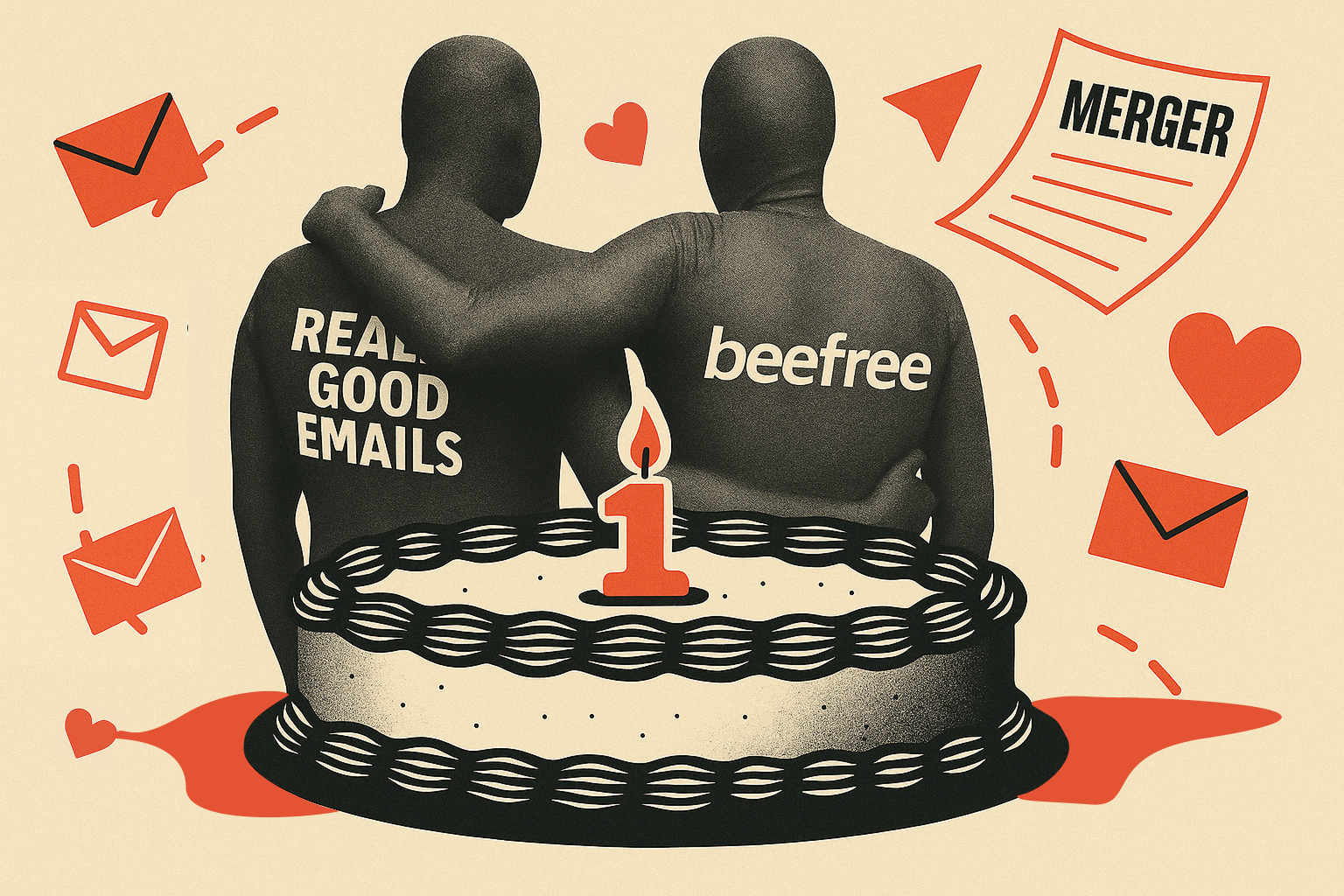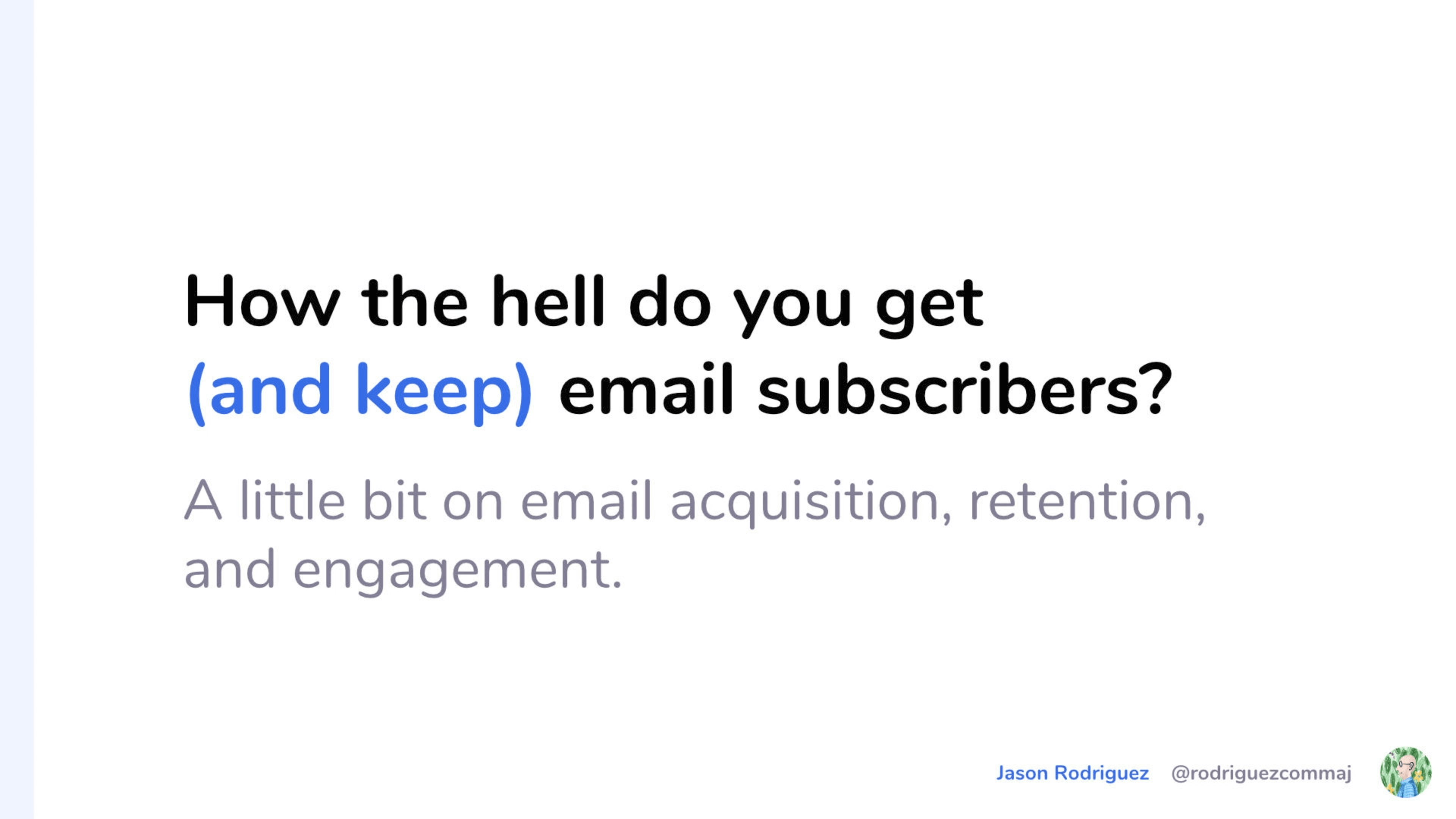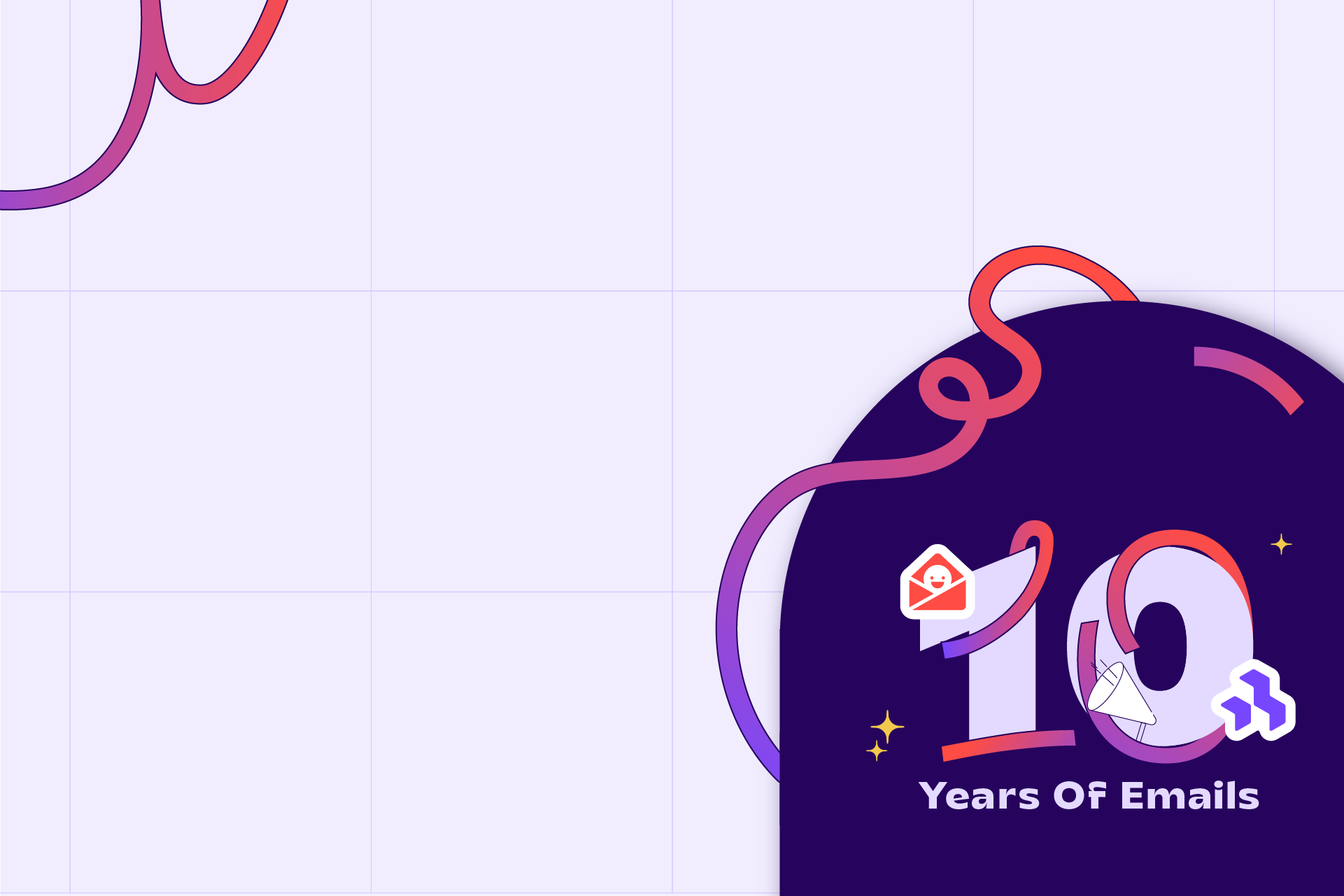Watch the full talk here.
Jason Rodriguez: I'm Jason Rodriguez. I work at Litmus.

I'm an evangelist, which is like the worst title ever, but I usually say I just go around teaching people about how to do email marketing and design and coding better.
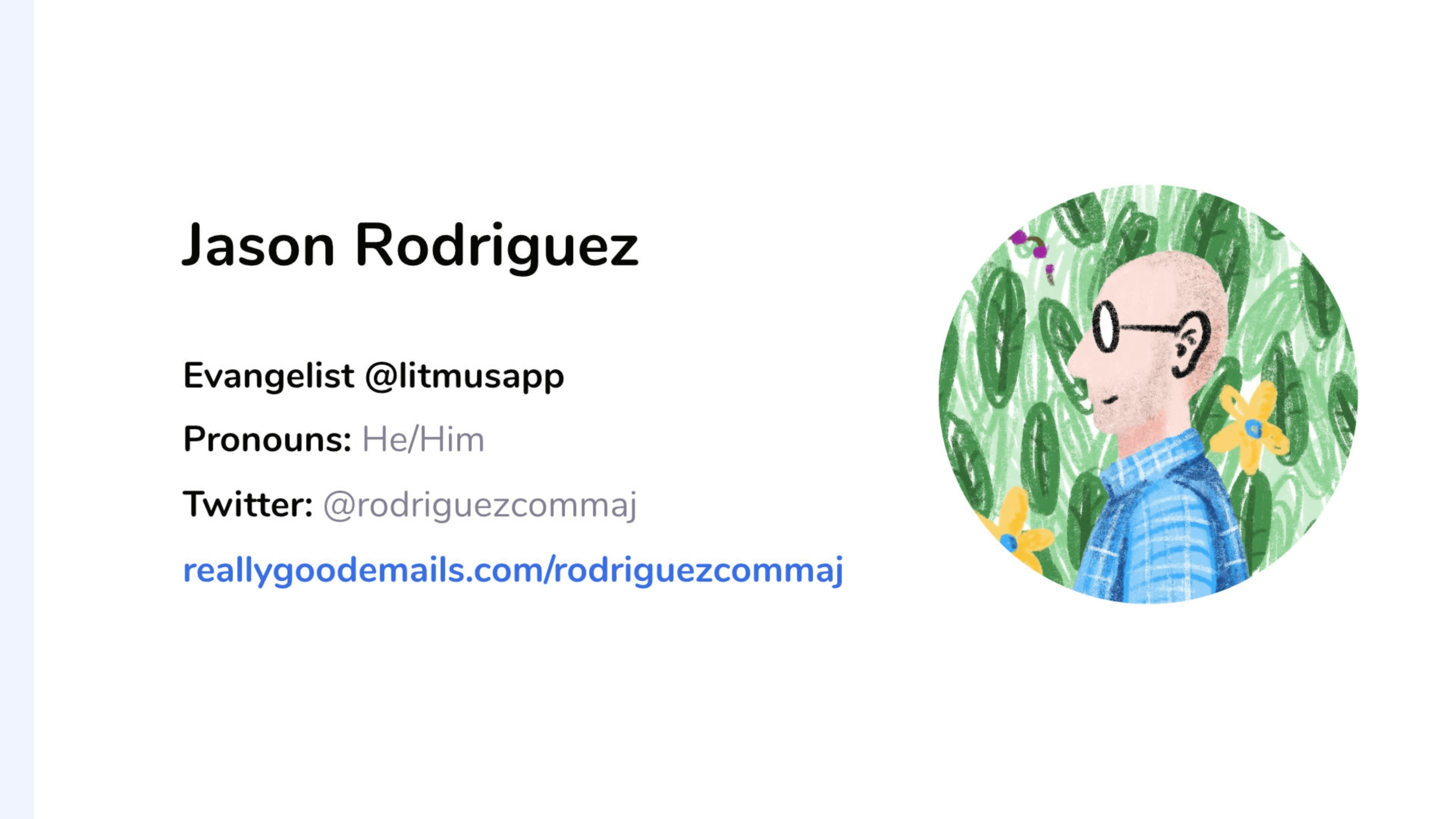
My pronouns are he/him. I'm on Twitter @RodriguezCommaJ. I have one of the fancy, Really Good Email profiles if you want to follow me there.
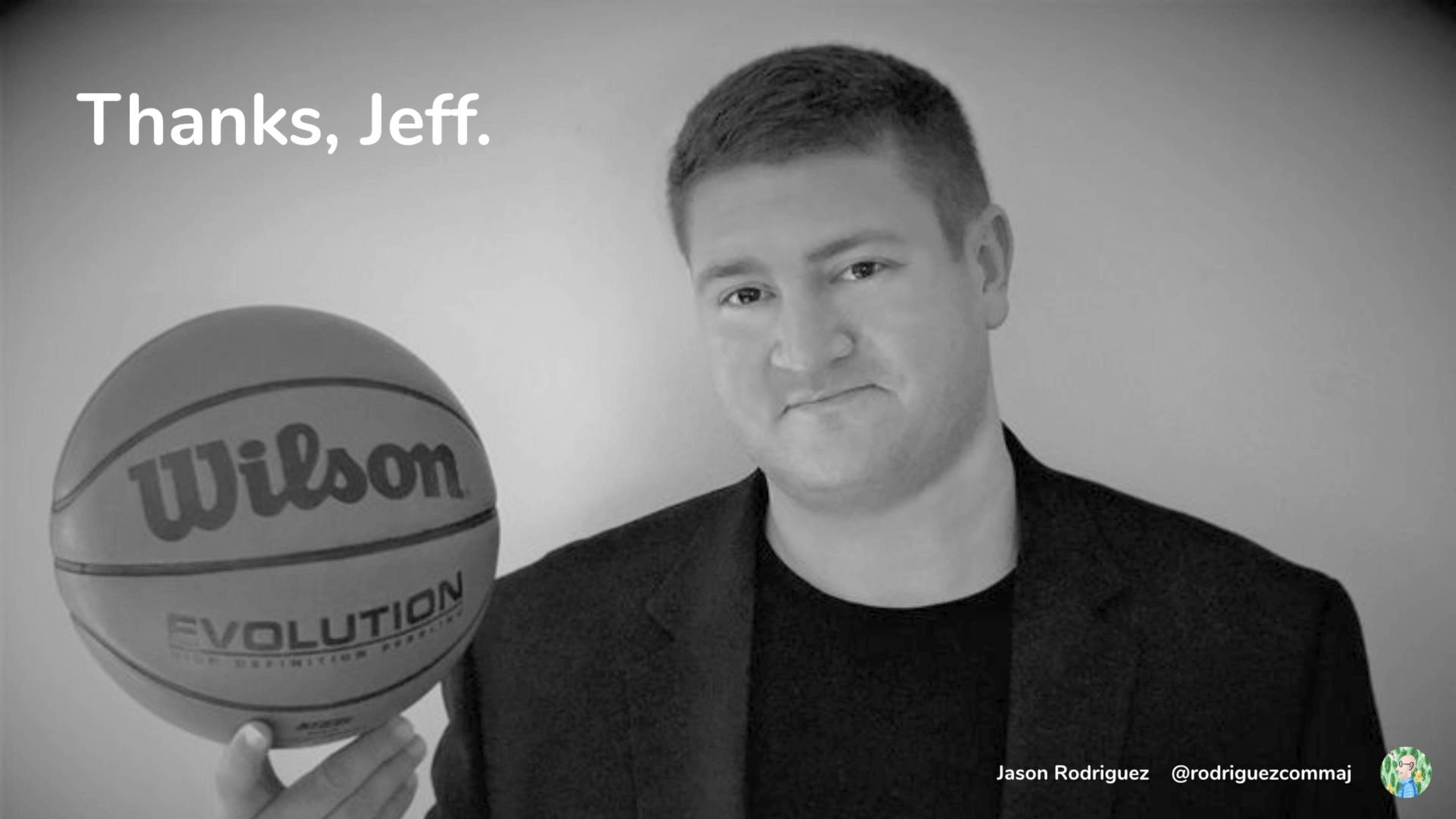
I have to say thanks to Jeff Yoder. He was the guy that was supposed to be up here on stage. I will be very honest that I cribbed a lot of this presentation from his slides, which Mike was kind enough to share with me.
Thank you, Jeff. Round of applause for Jeff, even though he wasn't able to make it here.
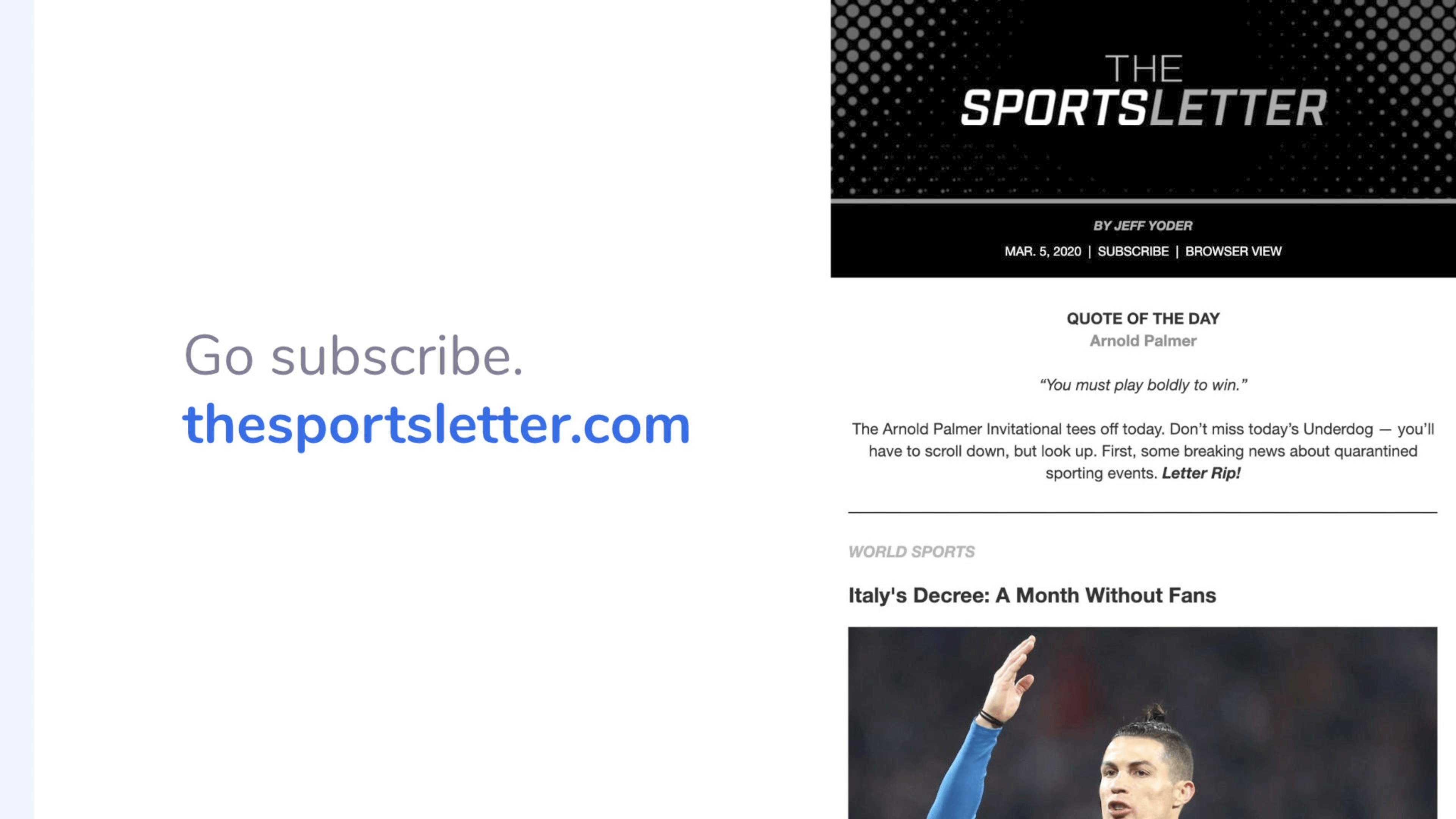
Jeff runs a newsletter called The Sportsletter, which you can sign up for it thesportsletter.com. It's a great digest. It's super short daily digest about sports news. He uses a lot of these things that I'm going to talk about today to drive email growth, and then perhaps more importantly to retain those email subscribers and effectively engage with them.
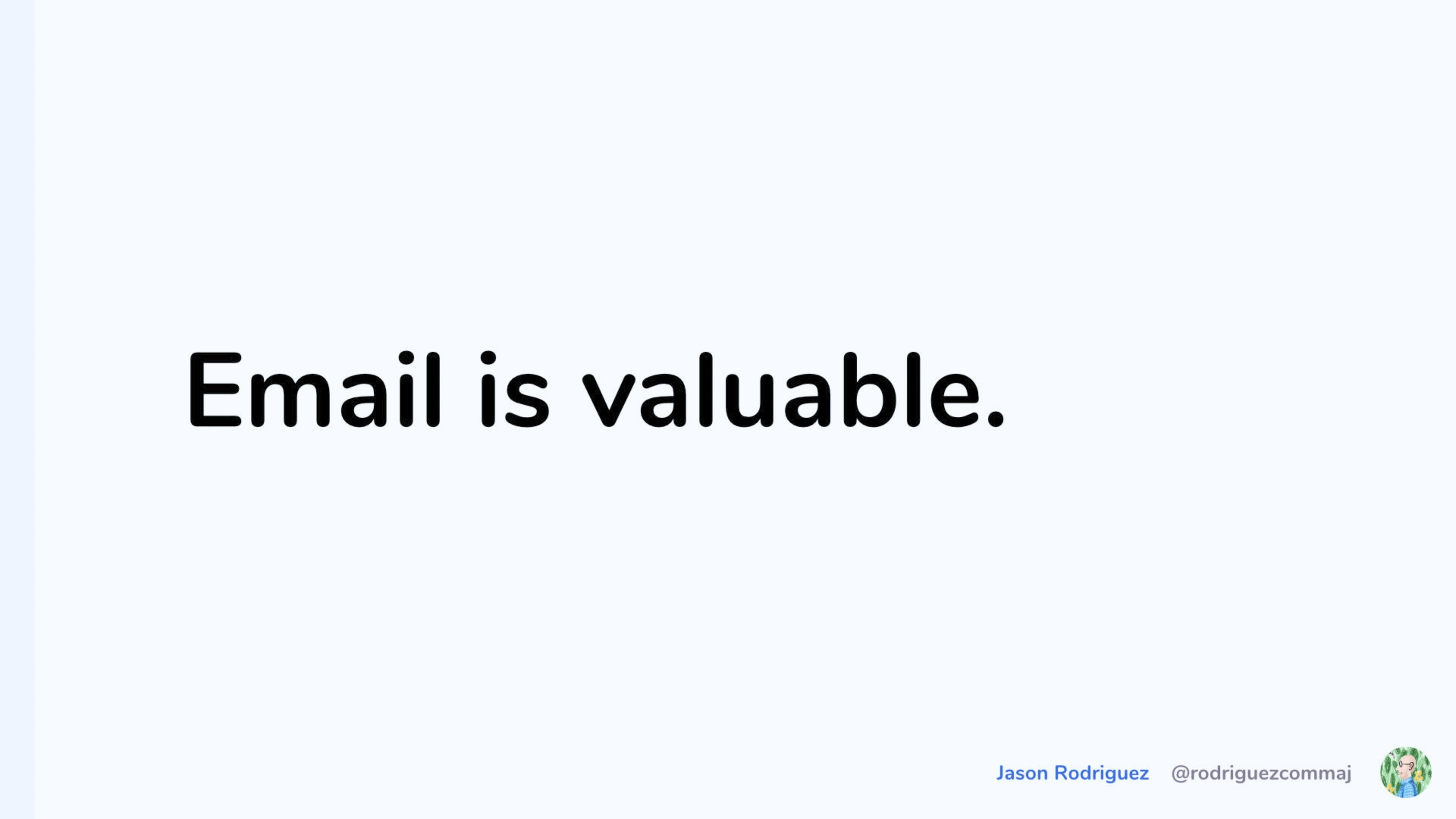
We all know that email is valuable. Hopefully, everybody here realizes that. At Litmus, we do a bunch of research around the value of email. I think that's from 2019, this number might have jumped up a little bit since then, but the average ROI for email marketing is 42 to 1.
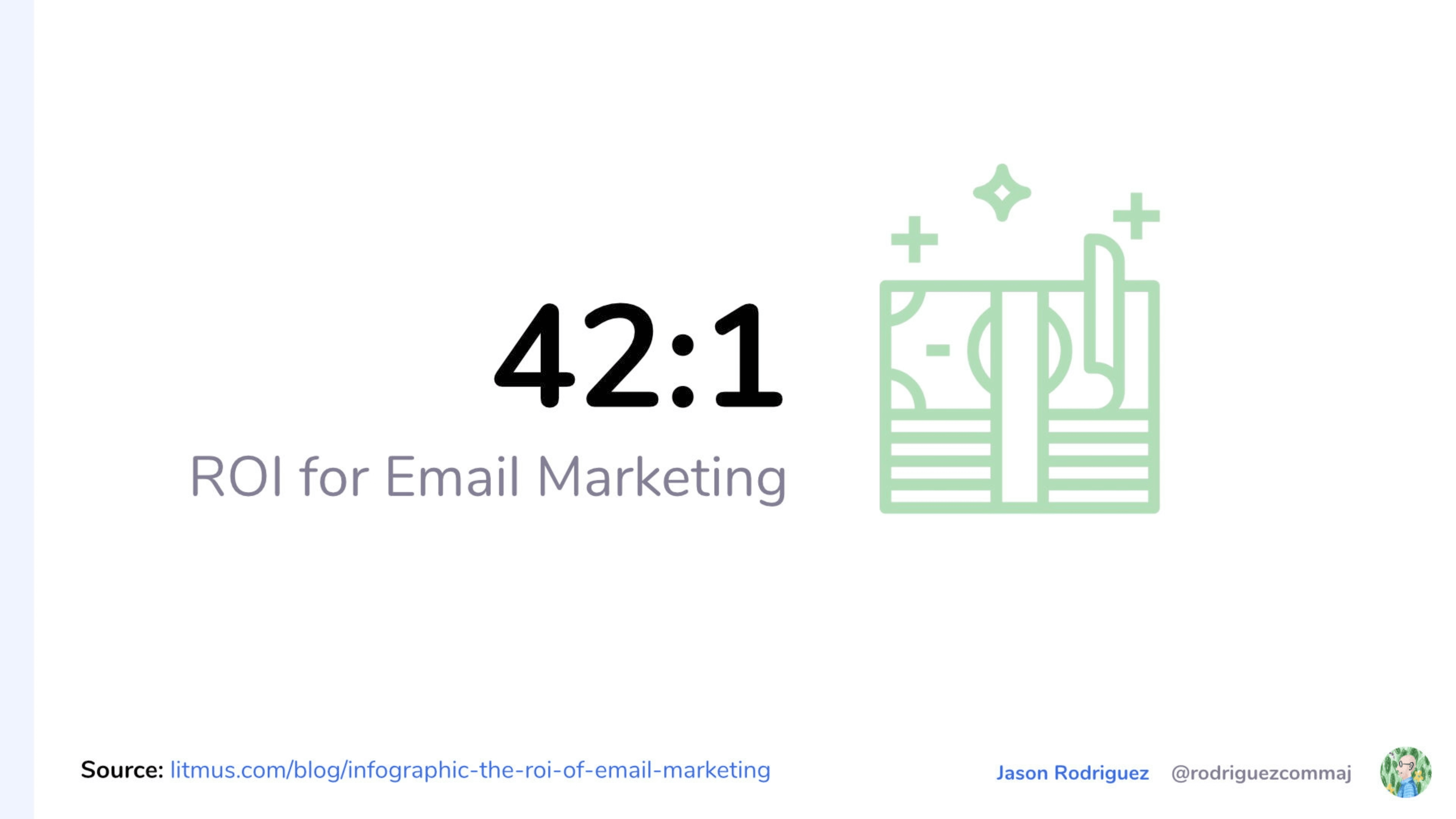
You spend a dollar, you get 42 back, which is pretty awesome. It routinely blows every other marketing channel out of the water, despite people saying email's dead. We hopefully all know that email is super valuable. We want to invest in it. We want to get as much as we can out of email marketing.

How do we do that? There's a couple of things we need to do. We need to get more people reading our email campaigns. We need to engage with the people reading those email campaigns more effectively. And hopefully retain them over the long term so that we can build these valuable relationships with people. I'm going to break that down into these three different sections here.

The first one is how do we get more people reading our emails? There's a lot of different techniques for doing that. The main one that most people are using is giving away free shit. The key here is to make sure that you don't give away shit itself. 💩
You want to make good stuff that people want to sign up for. At Litmus, we do a bunch of different reports. Chad White used to lead up all of the report creation and research at Litmus before he left us for Oracle. We have tons of great eBooks, tons of great stats. It's not unlike most other companies out there that have white papers, eBooks, all this research that they're releasing.
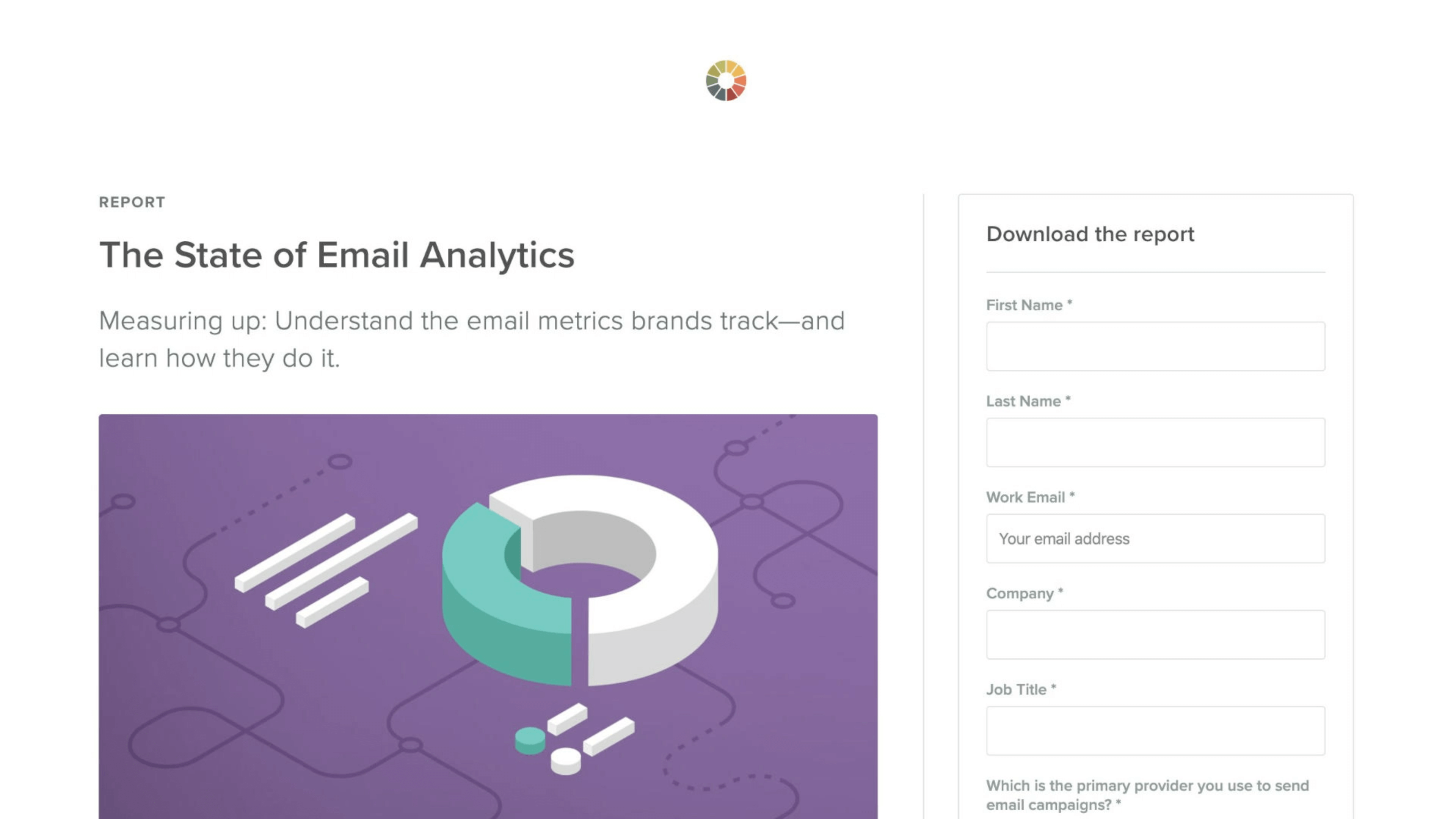
This is one of those key ways that we can get people to subscribe to our newsletters, sign up for things. Most often, there'll be some sort of like PDF or templates or worksheets or something like that are behind a gate that they need to use their email address to sign up. This is a great method for getting people subscribed, but it's kind of table stakes at this point.
Most people are using this kind of technique. Most subscribers expect to see things like this. There are sometimes far better ways to get people, to subscribe to your newsletter. A great thing that we try to do too at Litmus and I know it's done with The Sportsletter, is to use co-promotions.
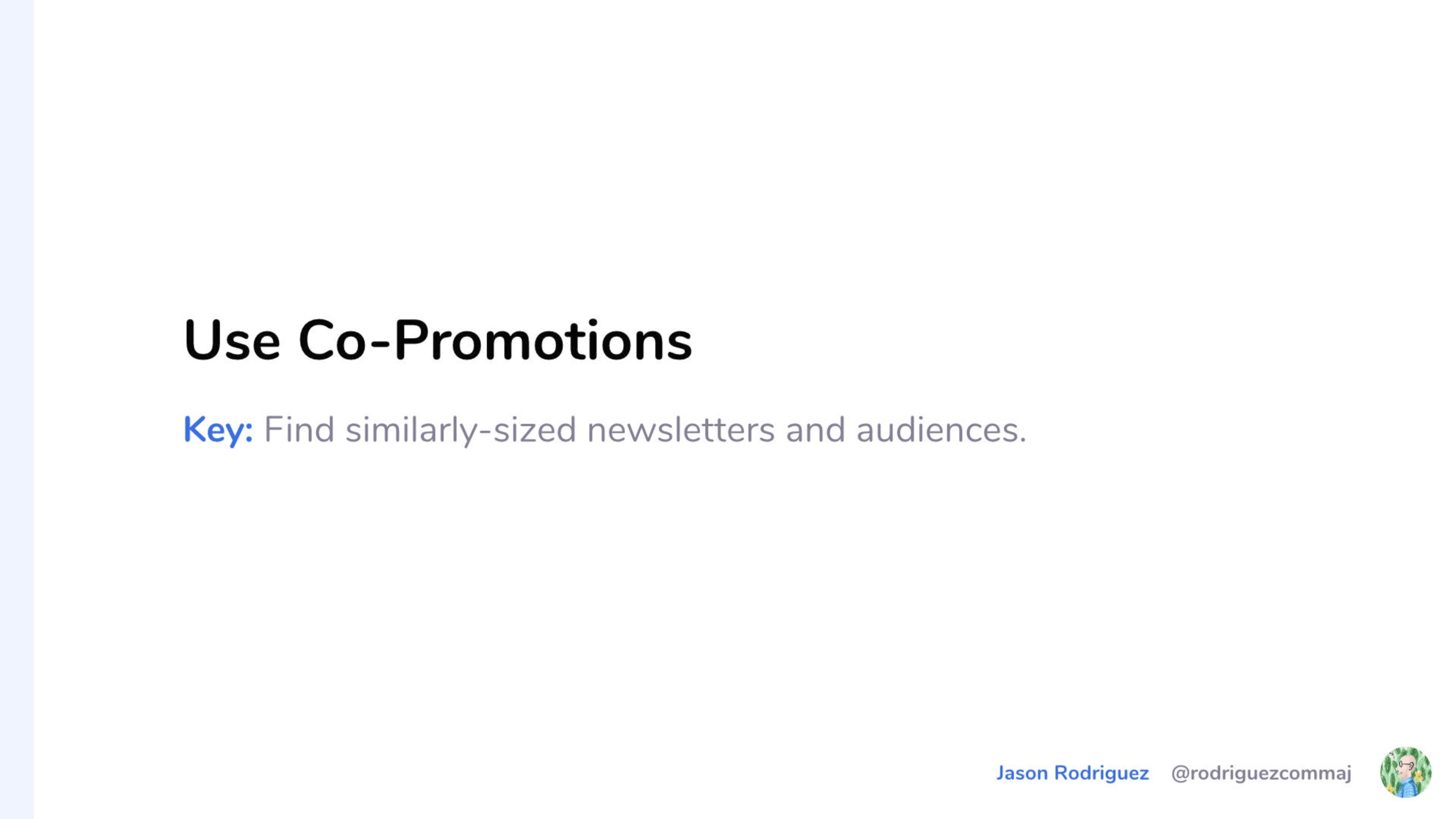
The key here is when you're trying to find people to promote with is to find both similarly sized newsletters. In the case of The Sportsletter, there's a bunch of different ones out there that are in the sports industry and that have similar subscribers. You want to find people that are similar sized newsletters, because they're most likely to have similar audiences as well. You're trying to tap into those audiences.
Co-promotions are great at Litmus. We do a lot of things with companies like Salesforce, HubSpot, Oracle, whoever. It's a great way to not only get more subscribers from those companies from that promotion experience, but also to spread the education email love around, which is great.
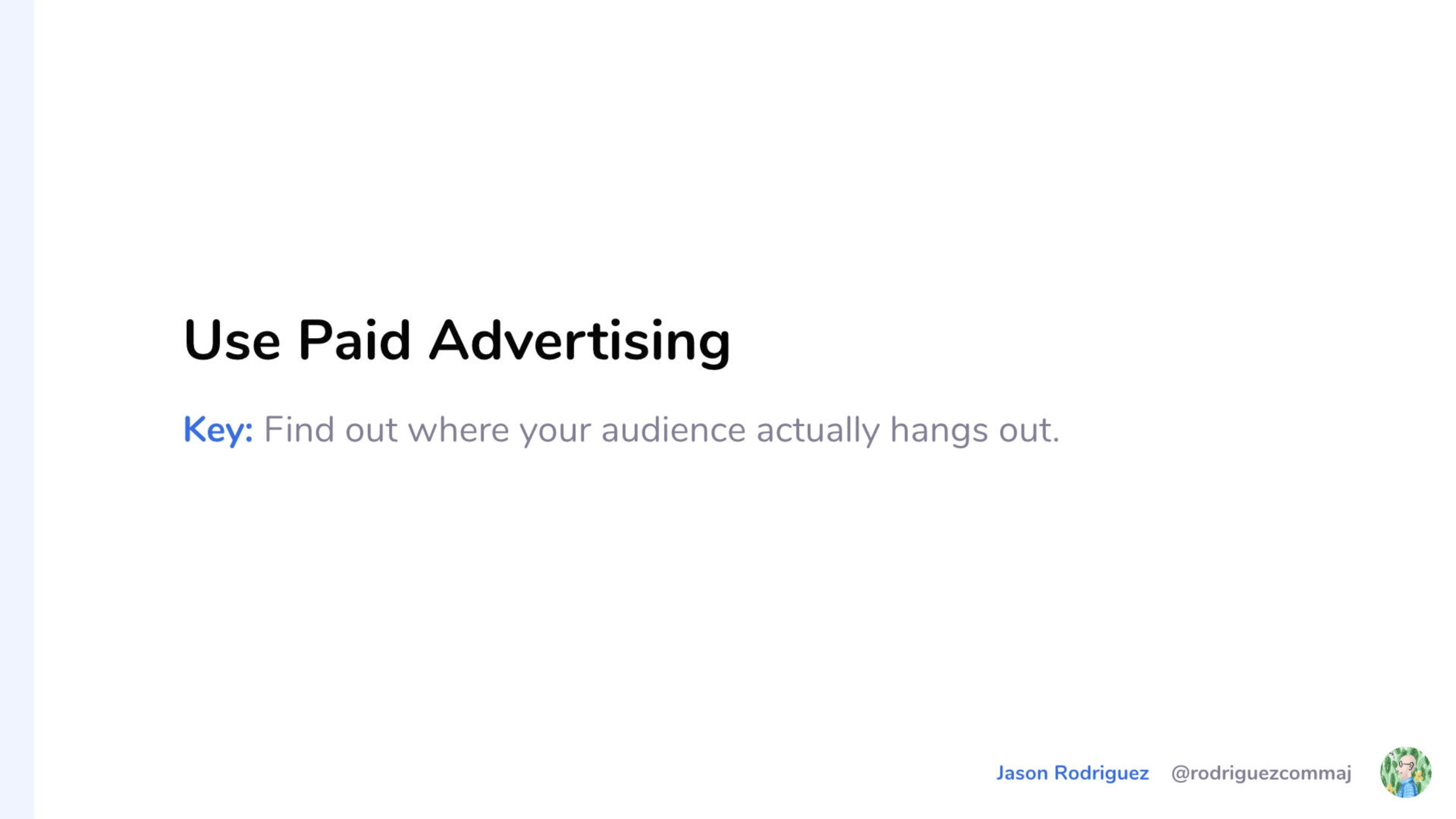
Paid advertising can work as well. The key here is to find out where that audience that you have or that you want hangs out. You can do paid advertising on pretty much any platform. YouTube, Facebook, Google, Instagram, wherever Those have different costs associated with them.
You don't want to just blindly spend money across all these different channels and hope for the best. The key here is to find out where the audience you want is actually spending their time and then try to target that audience specifically on those platforms and dedicate all of your budget to those targets, so that you can get the most out of them as well.
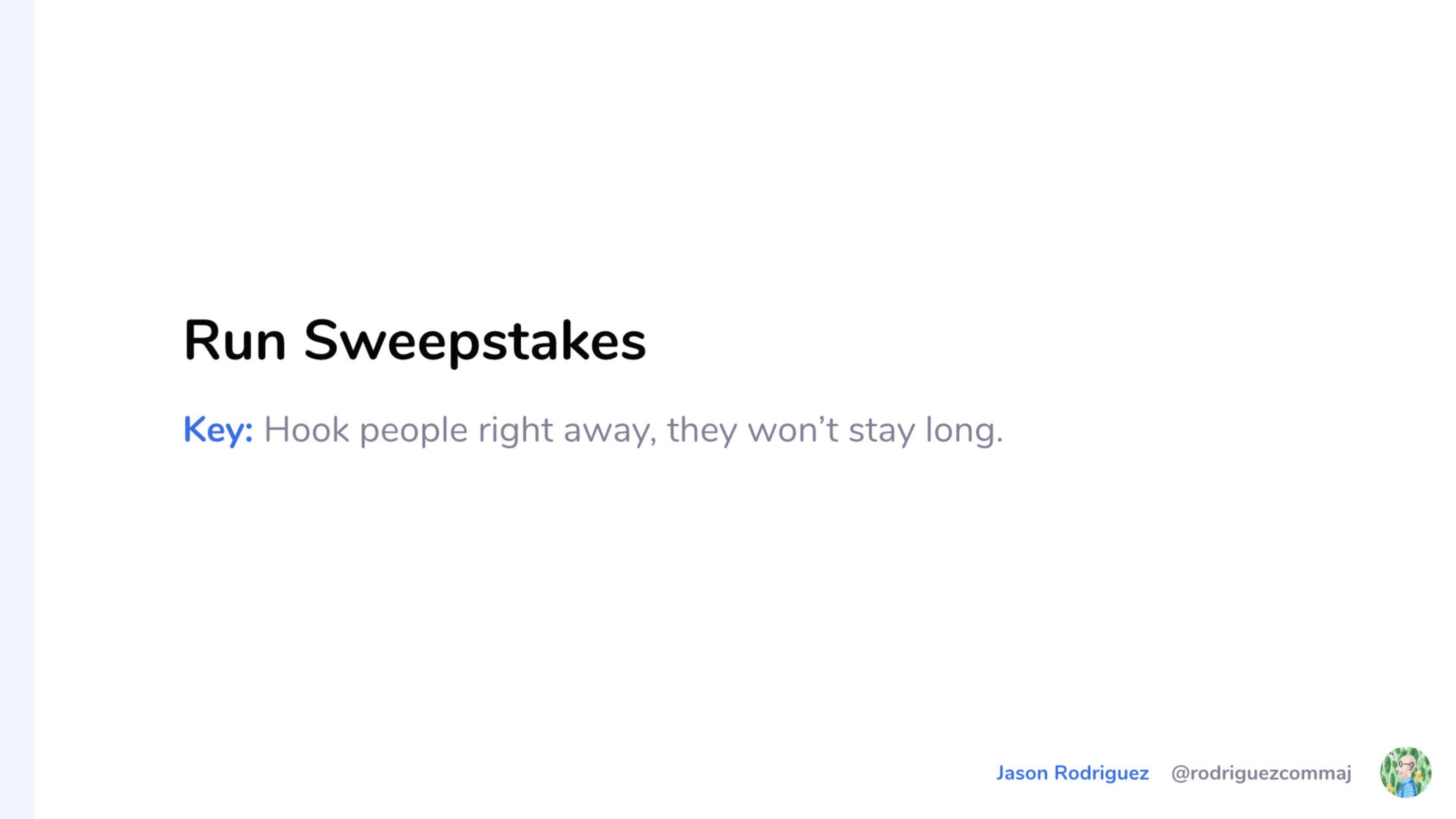
Sweepstakes can be a compelling way to get people to sign up for your newsletter. It's kind of like that give free shit away, but this is like bigger shit. This is like trips and TVs and Macbook Pros and all that good stuff. The key here is that when people sign up for sweepstakes, usually they have zero intention of sticking around, listening to you in your newsletter, and maintaining that longterm relationship.
The key here to hook them as soon as possible, once you get them on that list, try to figure out what resonates with them and send them that content immediately. You want to get them in right off the bat or else you're going to lose them pretty quickly.
It's a riskier thing, but if you have the budget to run a sweepstakes or partner with somebody that does sweepstakes that could potentially be a good way to grow that subscriber list. You got to get them quick, cause they're not going to stick around very long.
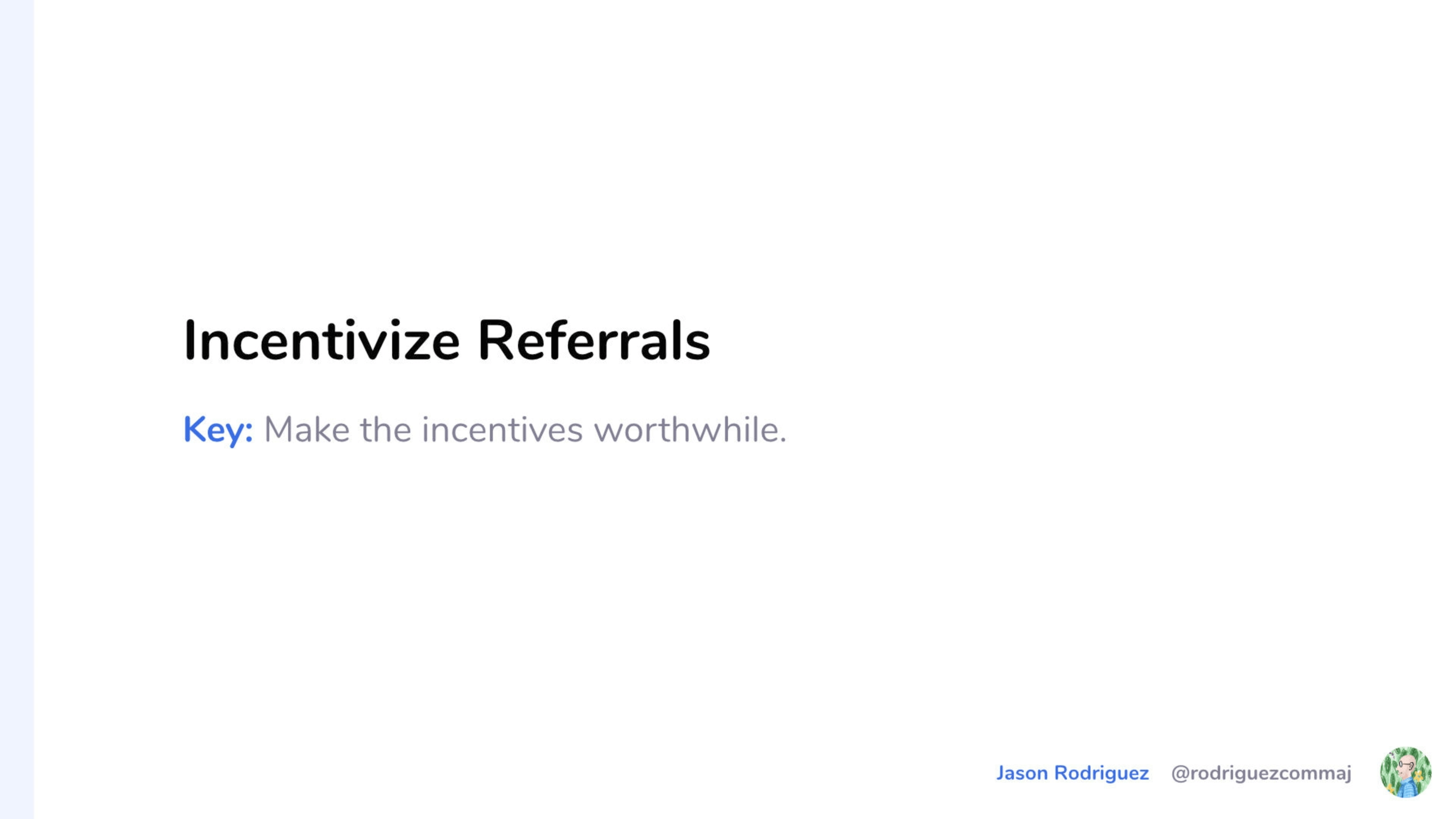
Then one of the best ways that works, not only for emails, but for just products in general and one of the ways that The Sportsletter has grown their email list, has been using incentivized referrals. You may be familiar with things like Dropbox that use incentivize referral programs.

I remember when Dropbox first came out. It was like a GIG free and then every person who referred it was like 500 megabytes extra or something like that. You better believe like me and my family and friends, we gamed the hell out of that so that we could get as much free storage as possible.
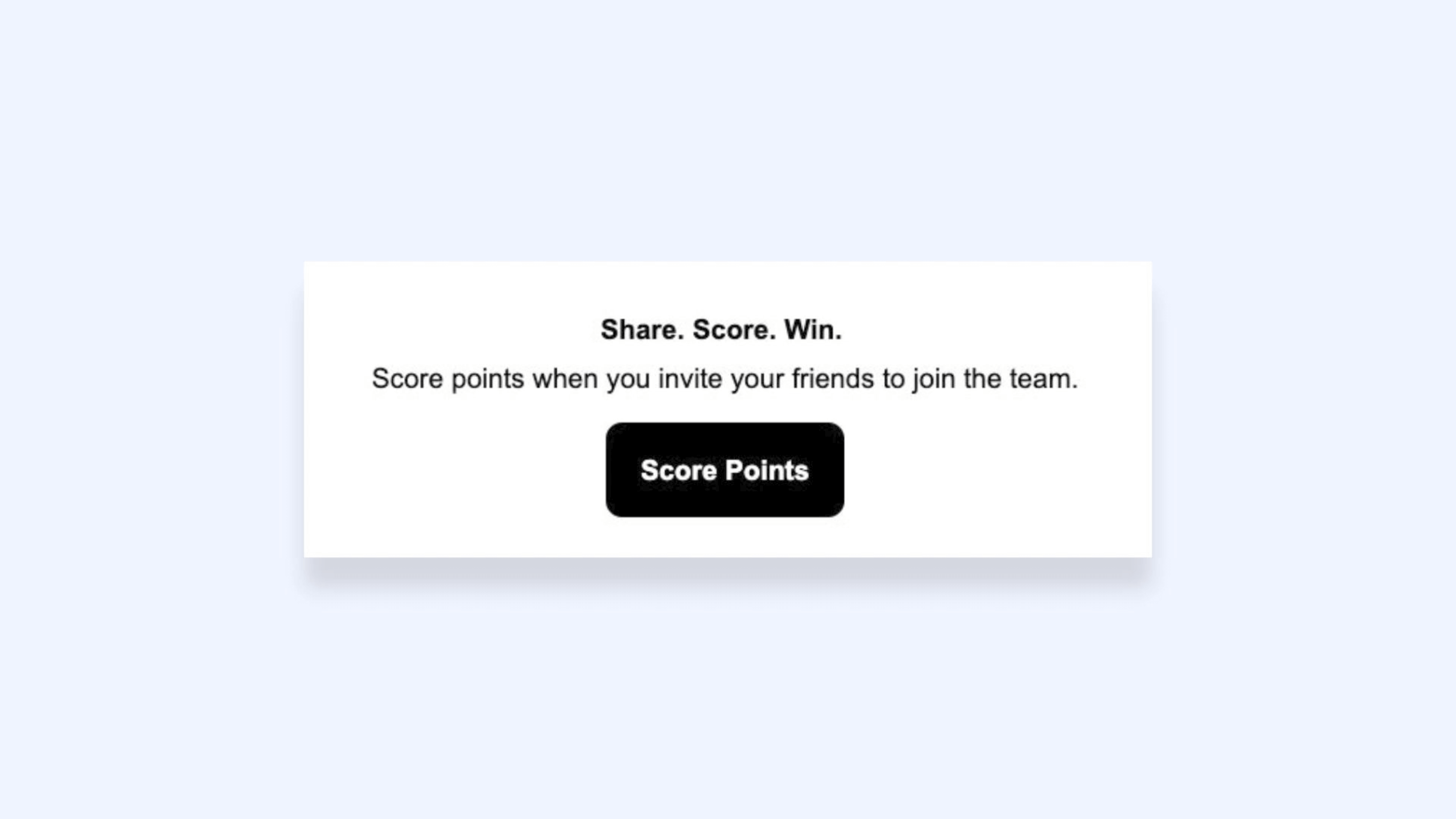
The same thing applies. You can do that in email. At The Sportsletter, they have this membership scoring program where if you refer a friend, they sign up for the email list with your referral link then you get to score points that you can use for different things that Sports Letter does.
Using this approach, this is one of those driving things that Jeff was able to use for The Sportsletter to grow his audience from essentially zero to over a hundred thousand within a year, which is pretty amazing growth. Those people have largely stuck around. They are current subscribers. It's created this really good relationship with everybody.
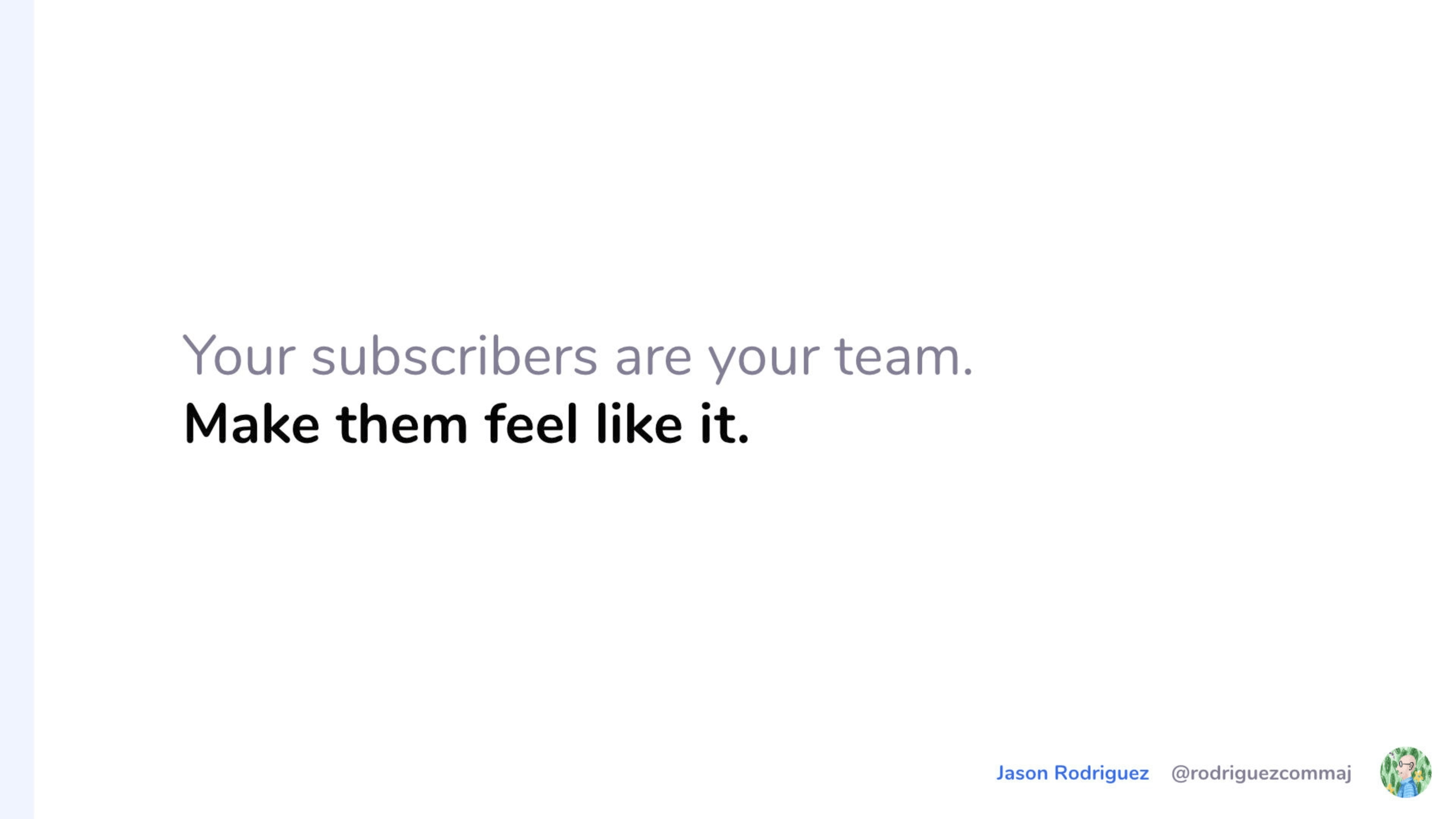
The key here is to make everybody feel like they're part of a team. I think that's an apt metaphor for The Sportsletter. Your subscribers are on your team. They want to hear from you. They want to create that relationship. So ideally when you're using something like a referral program, when you're talking to your subscribers, you're making them feel like a special part of the team.
You can do this in a variety of different ways. Those incentives could be different things. They could not only be like free storage on Dropbox, but they could be swag that you send out to them when they hit a certain threshold of people that they forward your email to. It could be personalized notes. It could be exclusive content.
Stuff that shows that you understand them as an audience and as subscribers and that you care about them and how they're helping to grow your team. I think that's something that applies not only for growth for your email program, just email in general. If you can get subscribers that love what you do in email, and it feels like they're part of the team, then they're going to do a lot of the heavy lifting for you when it comes to email growth.
That's something we've found over time at Litmus. As we create these like cool email experiences people love them and they're waiting for the next one, which could work against me when it comes to the conference stuff. But, hopefully not. Then they feel like they're part of team Litmus. They feel very devoted to the brand.
They feel very devoted to what we do in email. They love sharing all of that outside of the inbox. They forward things to friends. They tweet about it on Twitter. They talk about it on Instagram. We're very fortunate in that regard. That's only come through years and years of trying to understand them better. Try to make them feel like they're part of the team and trying to provide valuable content for them.

Once you get people on your team, once you get them signed up for the newsletter or whatever email you happen to be sending, how do you keep them reading your emails? There's a couple of key things here.
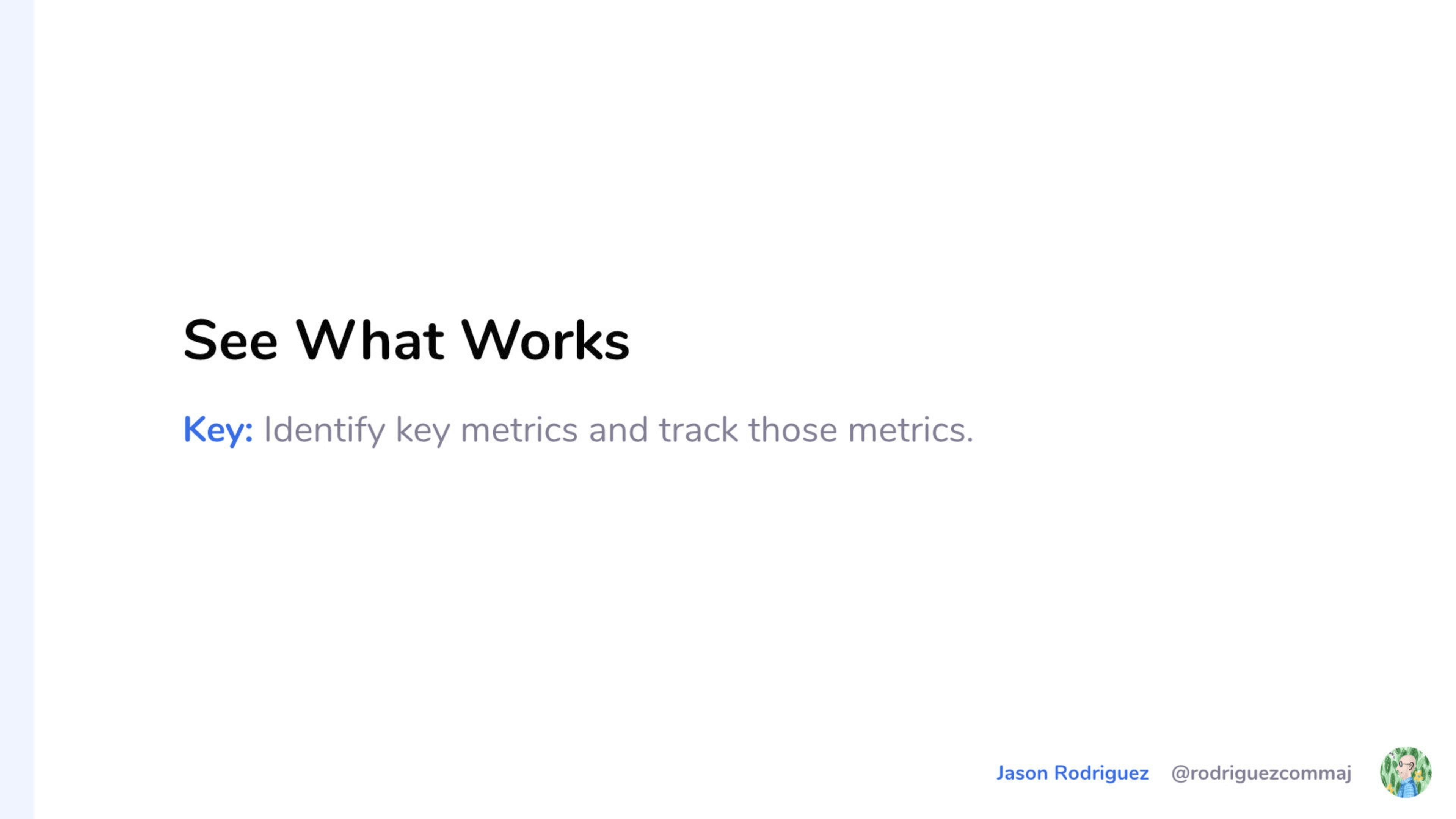
Number one is to see what works. Identify some key metrics and focus on those key metrics Figure out what metrics matter to you as a brand. Far too often, people are looking at vanity metrics like open rates, when more important things like click-through rates, click to open rates, lifetime subscriber value, money earned per subscribers, stuff like that could be far more important. Figure out which of those metrics actually matter and then focus on those things. Keep in mind a couple of different things.

Privacy matters. There's this growing discussion in the email world and the broader world around digital privacy and how much, if at all, that matters, especially in the email marketing world.
There've been a couple of developments recently where some pretty big name people and big-name companies have been railing against this idea of email tracking. They call tracking pixels, invisible spy pixels. They talk about how we shouldn't be able to see what people do in an email campaign and how we never got consent from them.
If you're compliant with GDPR, then I hope you got consent from your subscribers. I hope you're not going to get sued or anything like that. This is something to keep in mind that privacy does in fact matter. I expect to see a growing movement around digital privacy, especially in the email world.
It's something that we're going to have to take very seriously and figure out how we handle it as email marketers. Just keep that in mind. If you have that audience that's very privacy-focused, understand that there are other ways to track how effective your email campaigns are.

There are other ways to see what works in your newsletters and how to keep people engaged. I want to go through some of those different tactics that we could use.
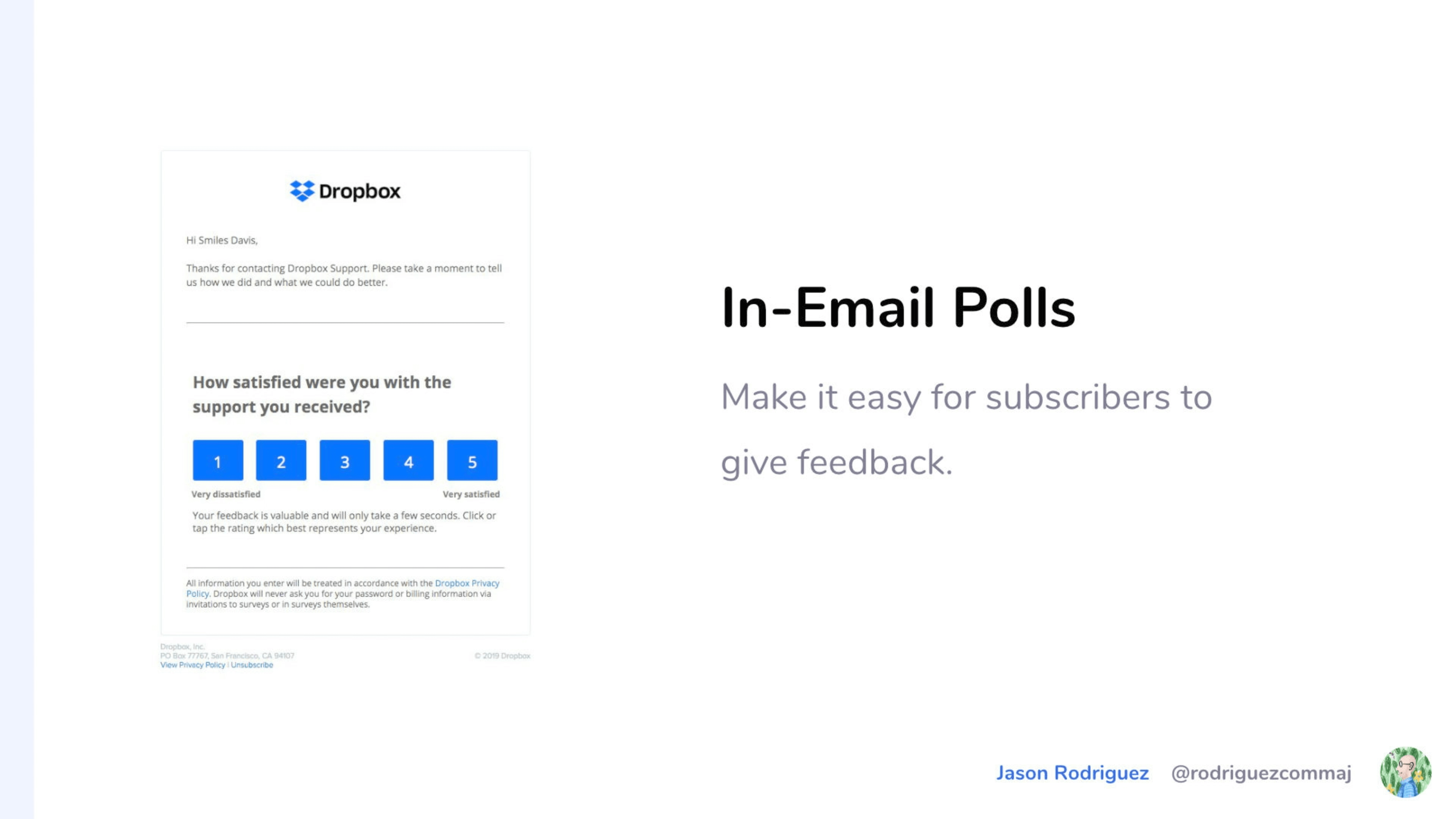
In-email polls are a great way to figure out what subscribers like. This might be a bad example. It's just in a poll, in an email from Dropbox asking you to rate your customer service experience. There's a lot of different tools, most ESPs have them, that allow you to add some sort of polling feature in your email campaign.
It can be an amazing way to get feedback from your subscribers about how well your campaign worked. It's usually pretty easy to set up. All of those are just individual links that you can track and then collect that information based on which of those links are clicked through.
You don't have to have collected any of that personally identifiable information. You don't have to have super-advanced tracking on this email campaign or worry about geolocation or anything like that. It's a simple way to do this. Just say, what do you think of this email newsletter? Is it valuable? Is it not? Then just get that feedback based on that.
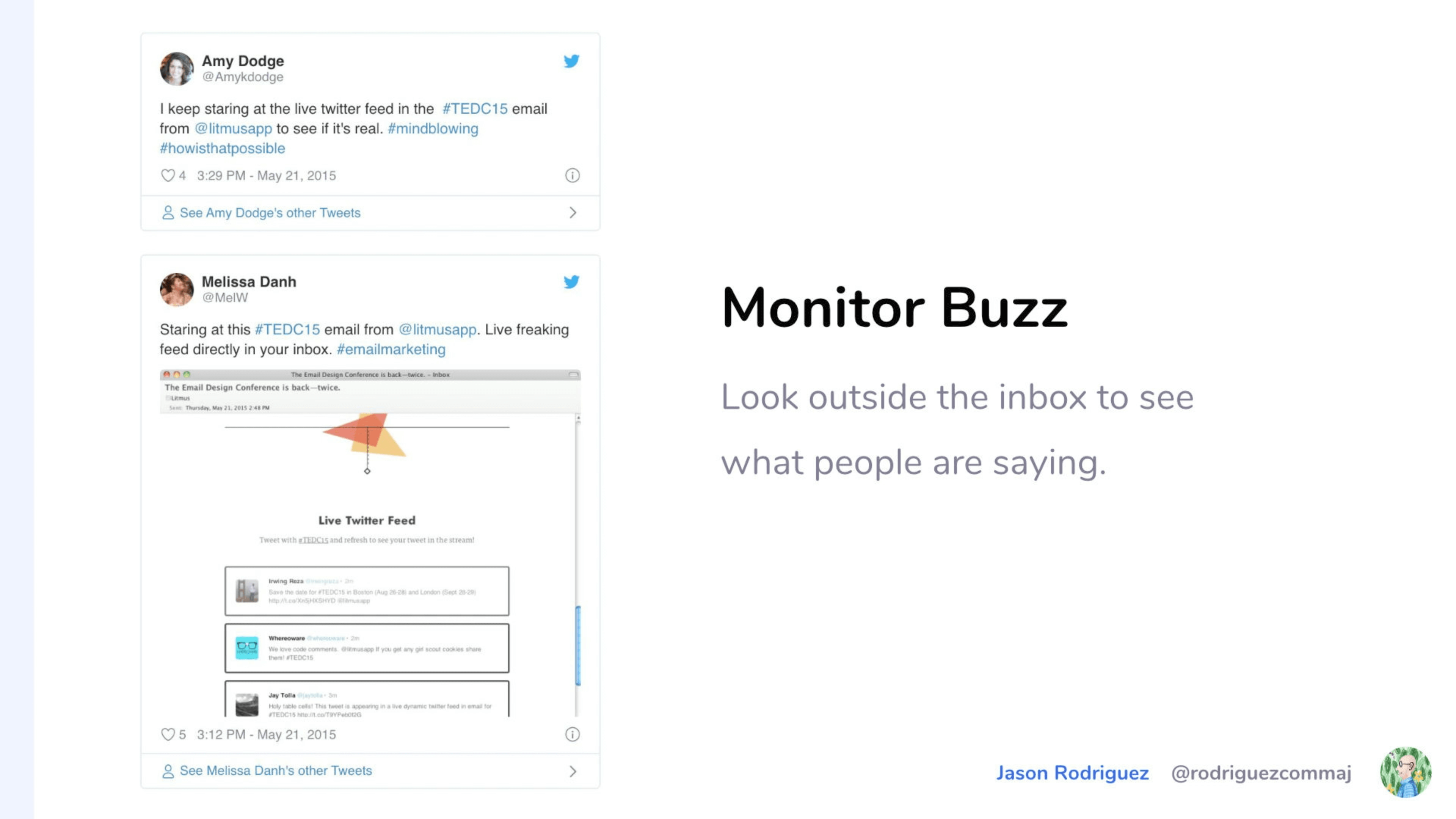
Monitoring buzz is just a great way to do it in general. This is one of the key things that we look at Litmus when we send an email campaign is how people are talking about it outside of the inbox. Many metrics are based around like what happens in the inbox, but a lot of times you can start really good conversations with people outside of the inbox.
Twitter's the main way that we do that because we have a very vocal audience on Twitter. We usually monitor after a send what people are saying about Litmus. Are they sharing screenshots? Are they taking screenshots of it in Lotus and giving a shit about how bad it looks in Lotus notes, our newsletter, because we have the kind of audience that'll take us to town about that.
Which is good and bad. It's a great way to get that feedback to figure out, do we need to fix our email campaigns in this specific client? Is this message resonating with people? Is this cool new technique that we tried out working for people or whatever it happens to be.
You should hopefully know where your audience is spending their time. What kind of channels they're using to talk to one another and talk about your brand. Identify that channel and listen to it closely. You can get some valuable feedback that way that doesn't include email tracking.

Starting a conversation with your subscribers is something I wholeheartedly encourage everyone to do. You need to start asking them to reply to your messages regularly. Making sure that you look at the replies to your email campaigns and respond to those replies is important.
People take time out of their day to give you that feedback. Far too often, companies will have the noreply@example.com email address set up, and it just goes to this blind inbox. That's a big lost opportunity because people are taking time out of their day to tell you what they think about your email. What they think about your content.
If you engage with those people, you reply to them, you start that conversation. That's one of the best feedback loops you could have as an email marketer, because you're hearing it directly from your subscribers. I see Dan. Do you have a question back there?
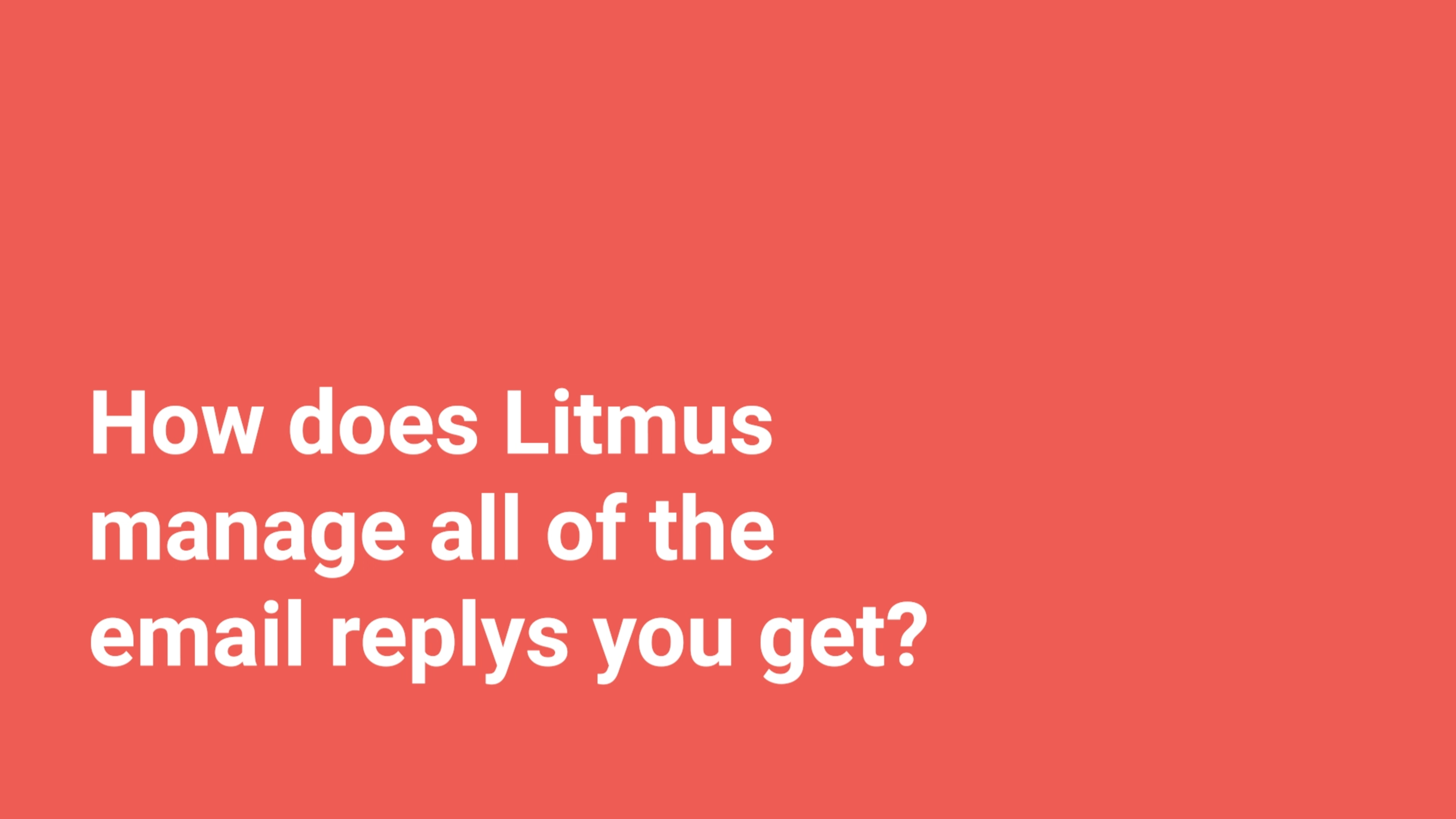
Dan Oshinsky: How does Litmus manage all of the email replies you get?
Jason Rodriguez: So the question is, Dan Oshinsky back there runs notanewsletter.com, which is one of my favorite recourses, highly recommend it. He asked how do we at Litmus manage, like looking at these conversations, reading up on them. So we're big Help Scout users. All of our support funnels through that. The email address that we have people reply to in an email campaign all goes into our Help Scout inbox.
Our people on our support team, they look at that all day every day. If there's a question that they can tackle, then they'll take care of it. They'll reply to customers. If there's something more pointed, like a design issue, they'll forward it over to someone on our email team like Alice Li or Lily Worth.
If there's something about the content and then they'll usually pass it along to whoever happened to write that blog post. As long as it's collected in one spot and it's regularly checked and you have those mechanisms for sending that out where it needs to go, then it's a super-effective way to manage all of that. I feel like most companies are using some sort of Help Scout or like customer support type tools. It's usually pretty easy to set that up. Cool.
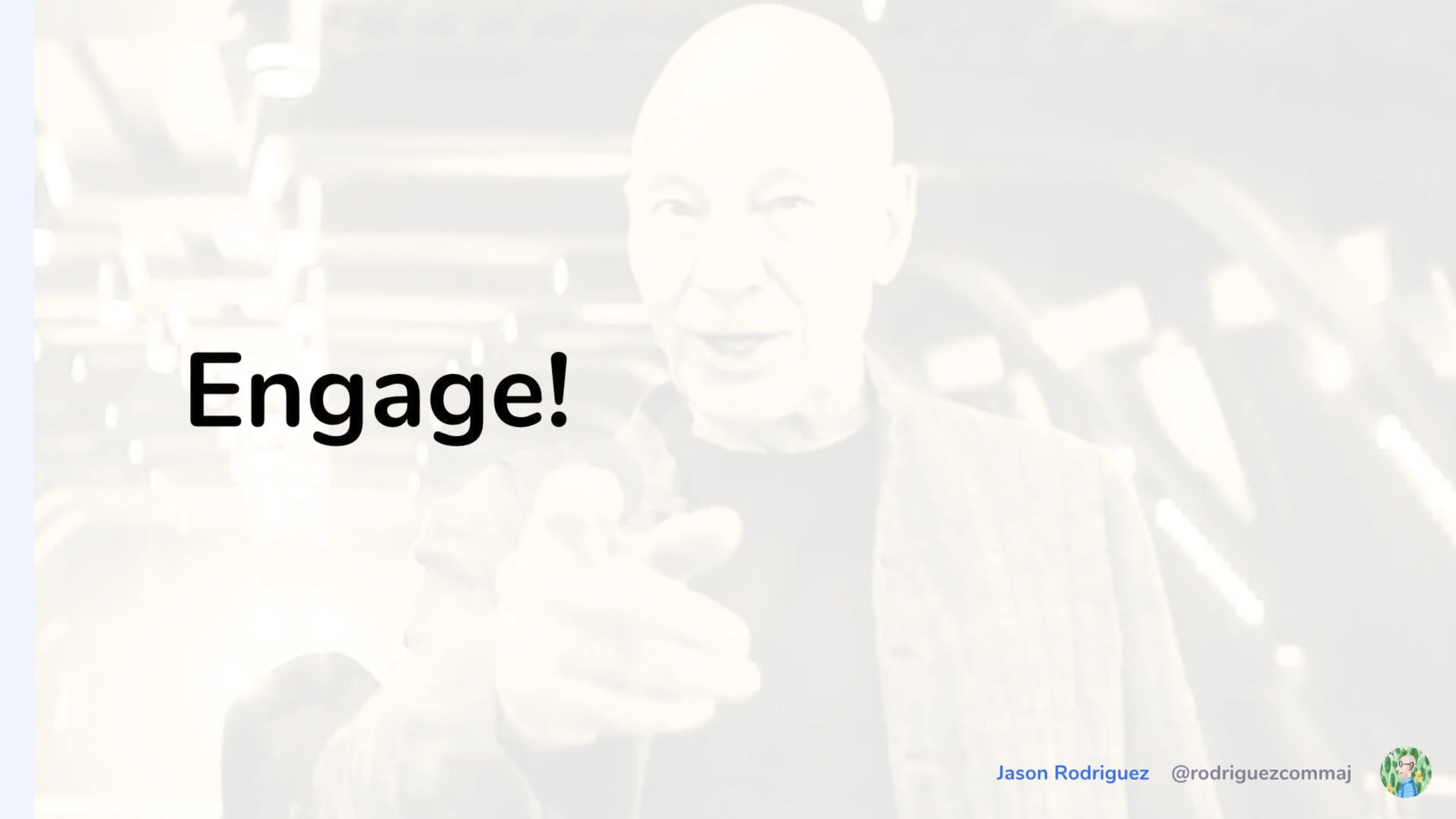
So after you have those people, after you get them reading your content and hopefully retaining, you're getting feedback from them. The next step is thoroughly engaging them.

So the number one thing you can do to engage your subscribers is to write something worth reading. A lot of times companies will just sort of collect whatever they happen to have that's laying around a blog. That's a direct mail piece, whatever it happens to be, and just dump it in a newsletter template. They won't edit it. They won't go through and make sure that it's important to their subscribers.
Step one is moving beyond that. Have those conversations. Look at your metrics. Figure out what content resonates with your audience and then gear all of your stuff towards that. Still experiment when you can. Still run all those different tests with content. This all goes back to understanding your subscribers and what they want and putting in the effort, spending money on copywriters, or training your people that you have to be effective copywriters and making sure you're writing something worth reading.

And design it well. If you're not an email designer, there's a ton of resources out there, more so than ever before to learn the sometimes dark art of email design and development. Spend the money on it. Spend the time getting good at email design because it's increasingly important.
Look through Really Good Emails. Focus on things like topography and accessibility and hierarchy and good imagery and all that cool stuff. Those fancy blobs, that Chobani forced on the world, which I love. Focus on those design concepts. See what's out there. See what other people are doing and design accordingly. That will draw people in.
It's double-edged to say the appearance of an email matters more than the content, but a lot of times it does It's that first impression you make. It's getting people sucked into the look of your email and invested enough that they're going to read the content of your email and get something out of it. So don't take email design lightly because it's a vital component of a successful email marketing strategy.
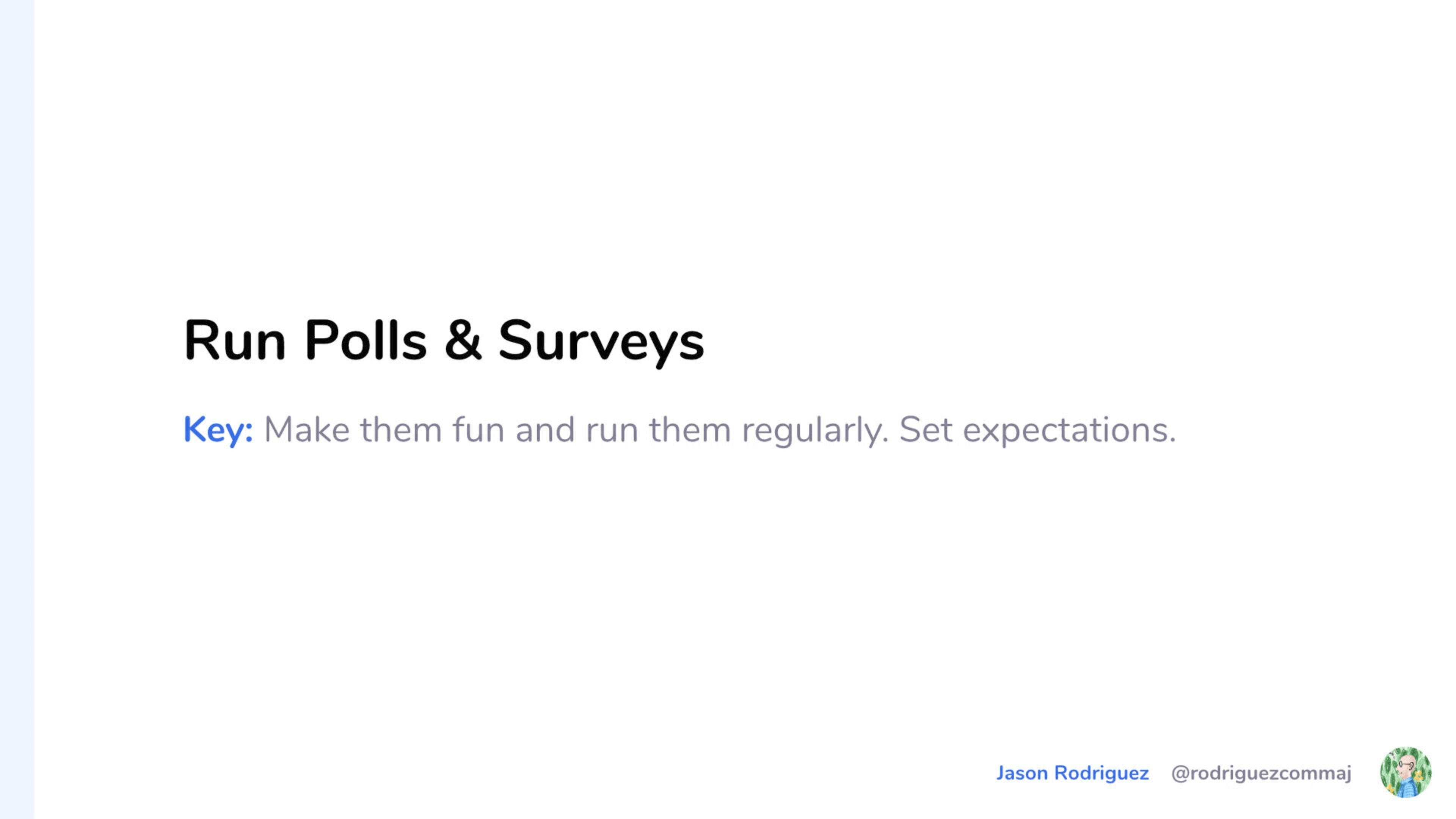
Some other cool things you can do are run polls and surveys in emails. Some great examples out there today. There's this guy that works at Aweber named Chris Vasquez, who spoke last year at Litmus Live.
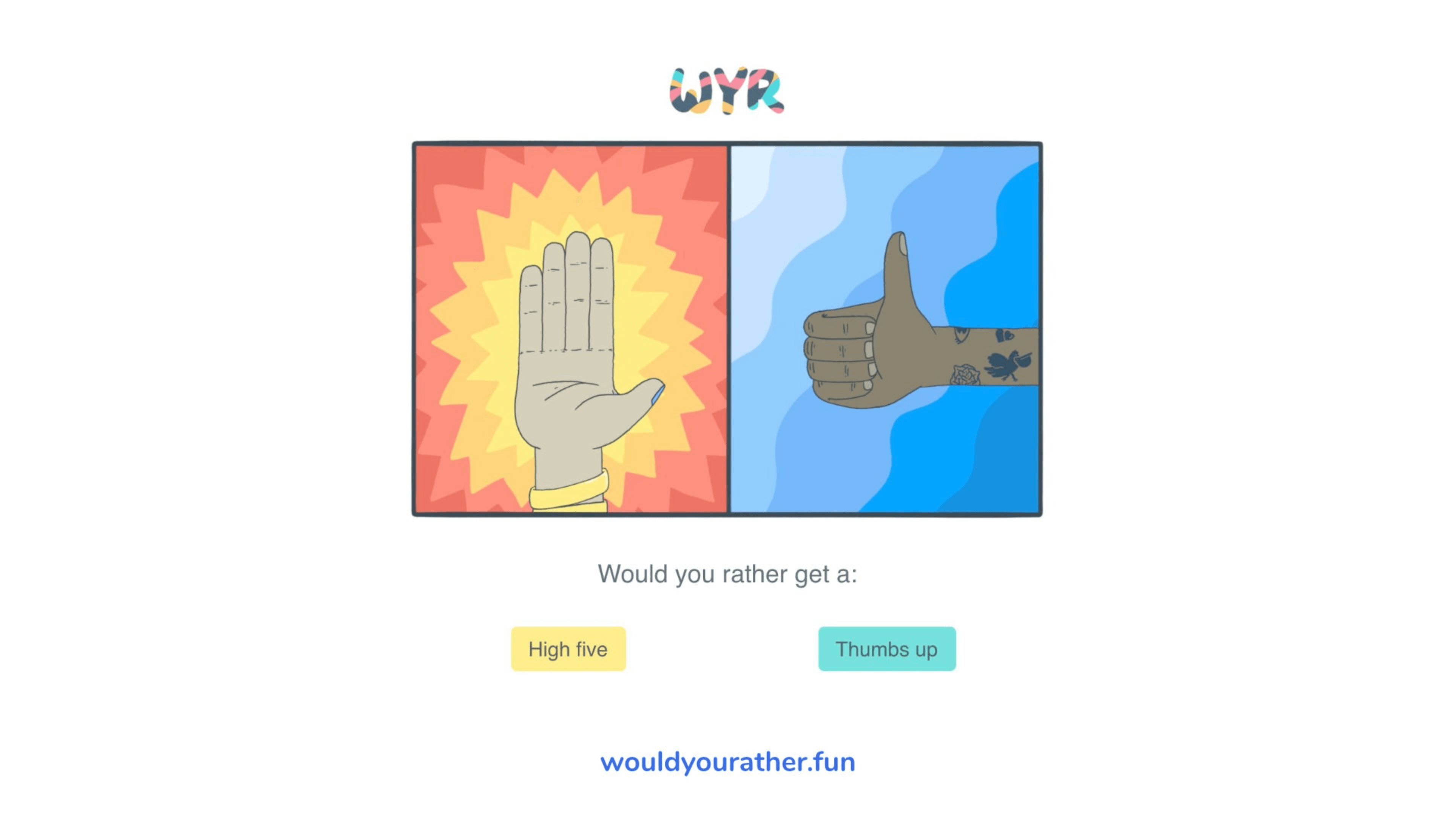
He runs this great newsletter that's called, Would You Rather. So we all know the game from middle school and high school, would you rather eat a pretzel covered in ketchup or would you rather spend two minutes with Donald Trump? I don't know. The whole idea is every email is one of these questions.
Would you rather do this or that? So would you rather get a high five or a thumbs up? That's the whole thing. It's just this built-in polling mechanism. That's the whole newsletter. It's this absurdly engaging newsletter campaign. I think I have another example, like where he uses that feedback later on here, but there's all kinds of stuff that people are doing.
Again, a lot of ESPs have that kind of tooling built out that allows you to add these fun polls. I would say two things to keep in mind if you're going to do something like this.
Make them fun. Don't make it just some like really dumb analytics type thing that you're trying to get some data for. Try to make them fun, engaging something people will want to lend their voice to.
Then try to set some expectations. If you're going to do something like this, start that strategy. Then try to do it regularly because it trains people to expect this fun component of your email. You'll turn them into just these rabid subscribers that are waiting for your next email campaign, which would be amazing to have subscribers like that.

So beyond that, start those conversations. Incorporate those conversations not only into the learnings and informing the content in your emails, but you can incorporate those conversations into the actual content of your emails as well.
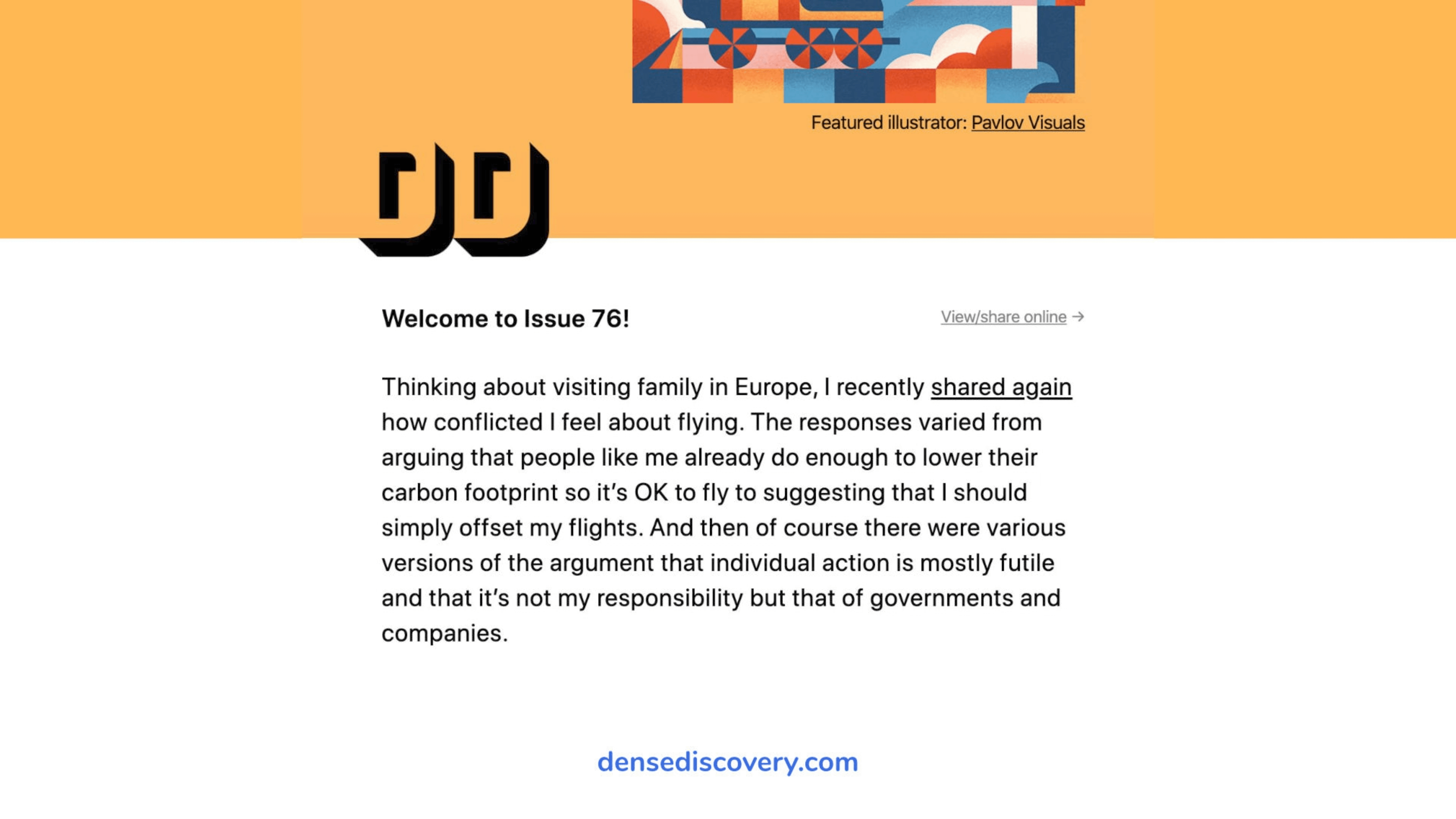
A great newsletter is called, Dense Discovery. Kai Brach runs it. It's a collection of cool design articles. Things like product focuses. All kinds of different things. One of the good things that he does is, invite people to have conversations with him. So you can reply to the email, talk about something that he was talking about in the email, and especially the last couple of newsletters he's been having this very public, but internal debate about how seriously he should take climate change. Especially as somebody that's a digital nomad.
The guy that runs this travels a lot. He was talking to about taking a trip to see some family and how that would require him to fly. As we all know, air traffic is one of the biggest contributors to climate change. So he's doing this publicly and he's getting all these amazing responses from subscribers. Then he's working those into that next email campaign.
He talks about what people were saying. He talks about their thoughts, how they relate to what he was sharing with everybody. It's creating this awesome conversation that people like me, I love getting this newsletter and seeing what he's talking about, what other subscribers are telling him and how that conversation is growing.
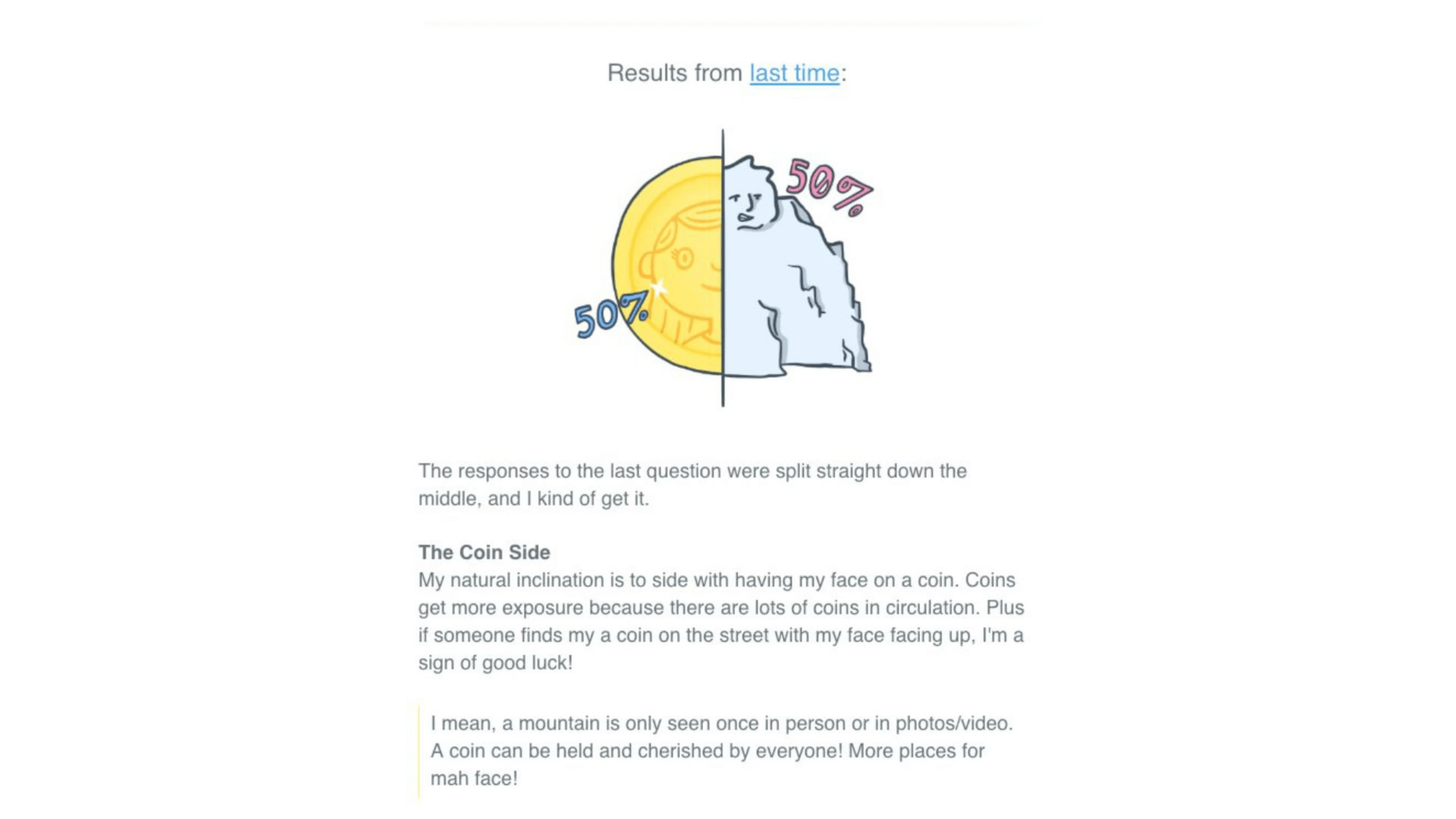
When we look at Would You Rather, he incorporates the results from the last newsletter into the bottom after that poll in the next newsletter. A lot of times Chris will show the results. I think this one was would you rather have your face on a coin or a mountain? It was kind of interesting. The 50/50 split, I would say coin all the way. More people are going to see that and I just want to get my face out there.
He incorporates feedback and even has quotes from people because once you click through on that poll, there's a form to collect why would you want to have your face on a coin? Or why would you rather get a high five as opposed to a thumbs up? He brings that in the newsletter. So again, it's creating that expectation. It's sharing that conversation. You're having those subscribers and it's creating this like amazing engaging experience.
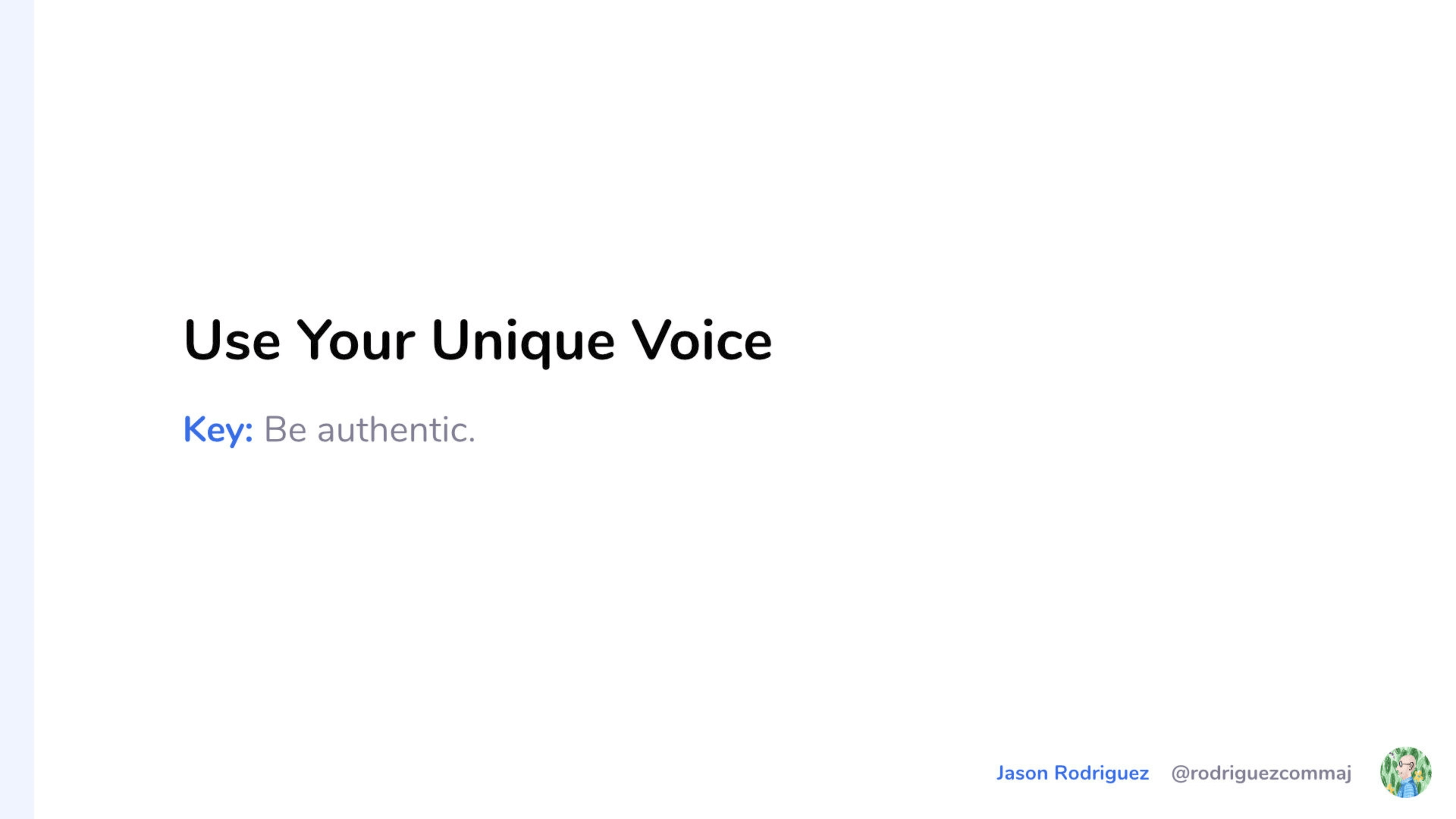
Then finally, use your unique voice. The key here is to be authentic. Don't chase trends just for the sake of chasing them, just for the sake of them being trendy. You want to know what your voice is. It might take a while to get there, to experiment with different copywriting techniques, different visual designs, but try to understand your voice. What you believe, what your values are, and try to express that authentically and then share that with your audience.
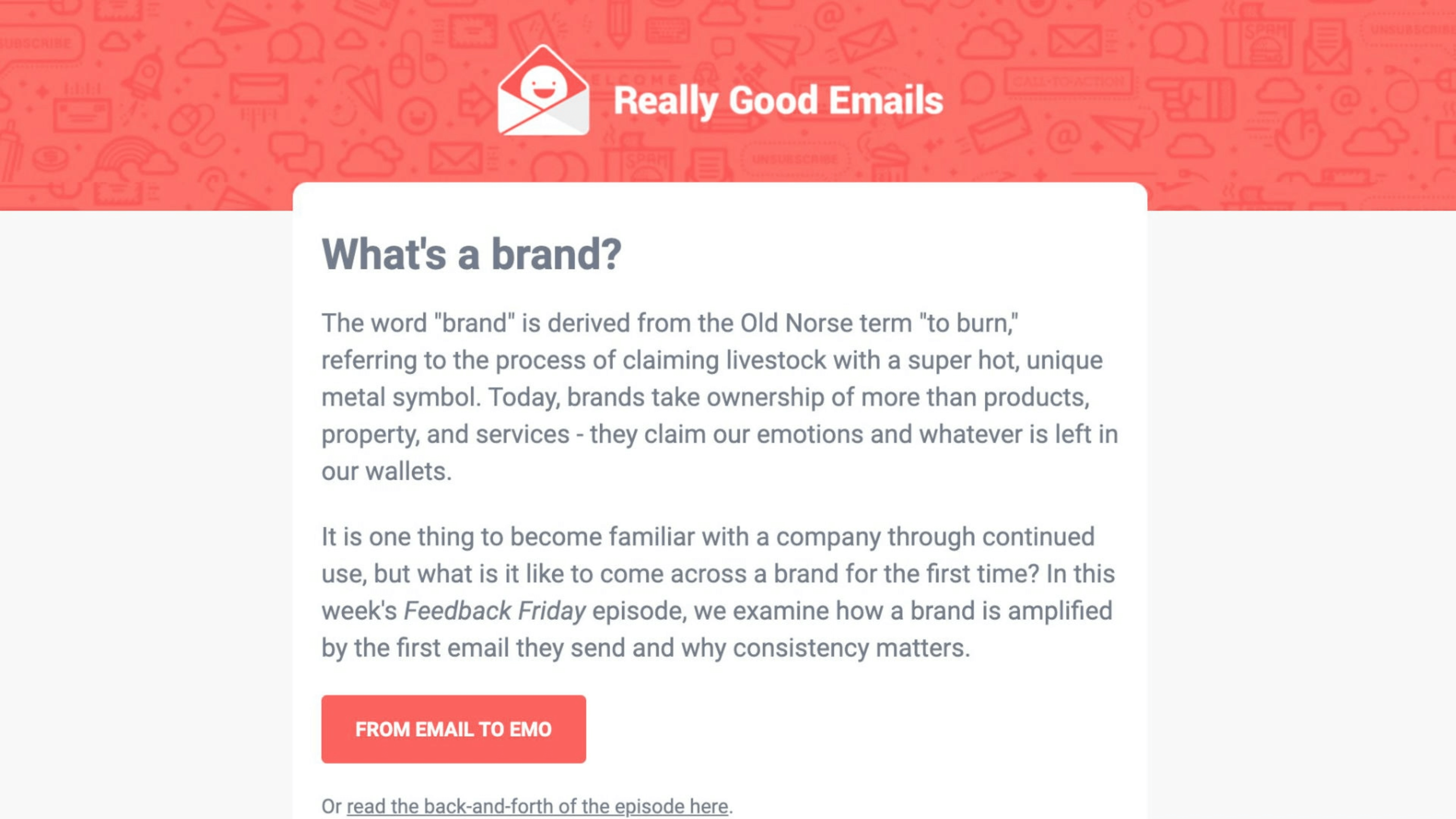
I think we can all agree. Probably the best example of this that we know is the team at Really Good Emails. We are hopefully all familiar with their newsletters. They're awesome website, their Feedback Friday videos, all that kind of stuff. They have a specific, humorous, fun brand that comes through. It's just infused throughout everything they do, including this conference.
People know when they read a bit of copy that it is from the Really Good Emails team. We've done a bunch of webinars with them and it's fun to get into that Google doc with Matthew or Mike. We sometimes have to like tamper that voice a little bit because it's so strong. Matthew's back there laughing. He knows what I'm talking about. A lot of talk of unicorns and like nonexistent Pokemon species and all that kind of stuff.
They have such a strong voice that it goes through everything they have and it creates, again, this really good personality that people are ready to engage with and are excited to engage with. Right.
I have no idea how I'm doing on time, but I'm almost done. So we'll see how this goes.
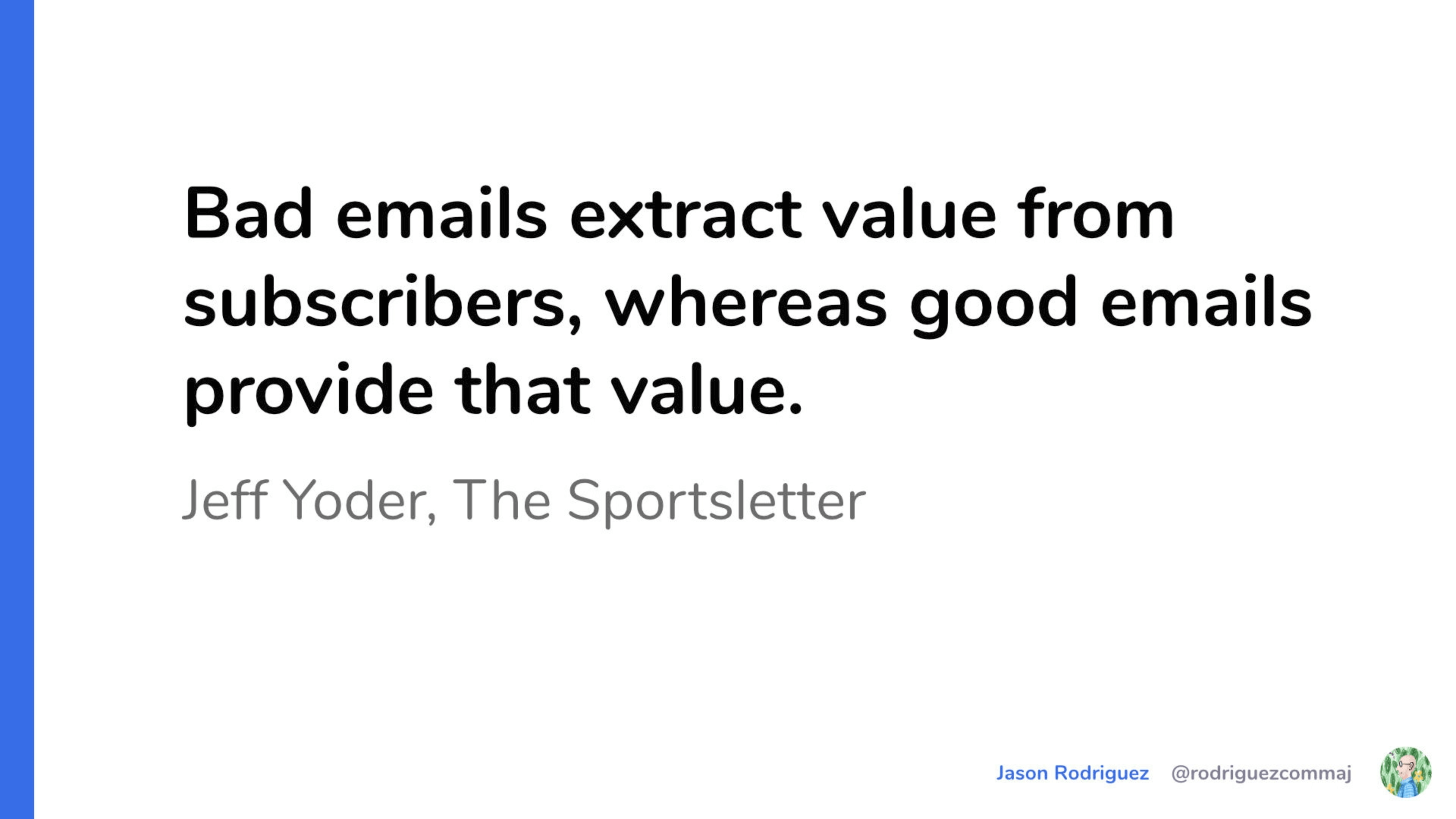
Jeff, in his slides, I was happy to take this out of there because I think it's a great quote from him, but he said that, "Bad emails extract value from subscribers, whereas good emails provide that value."
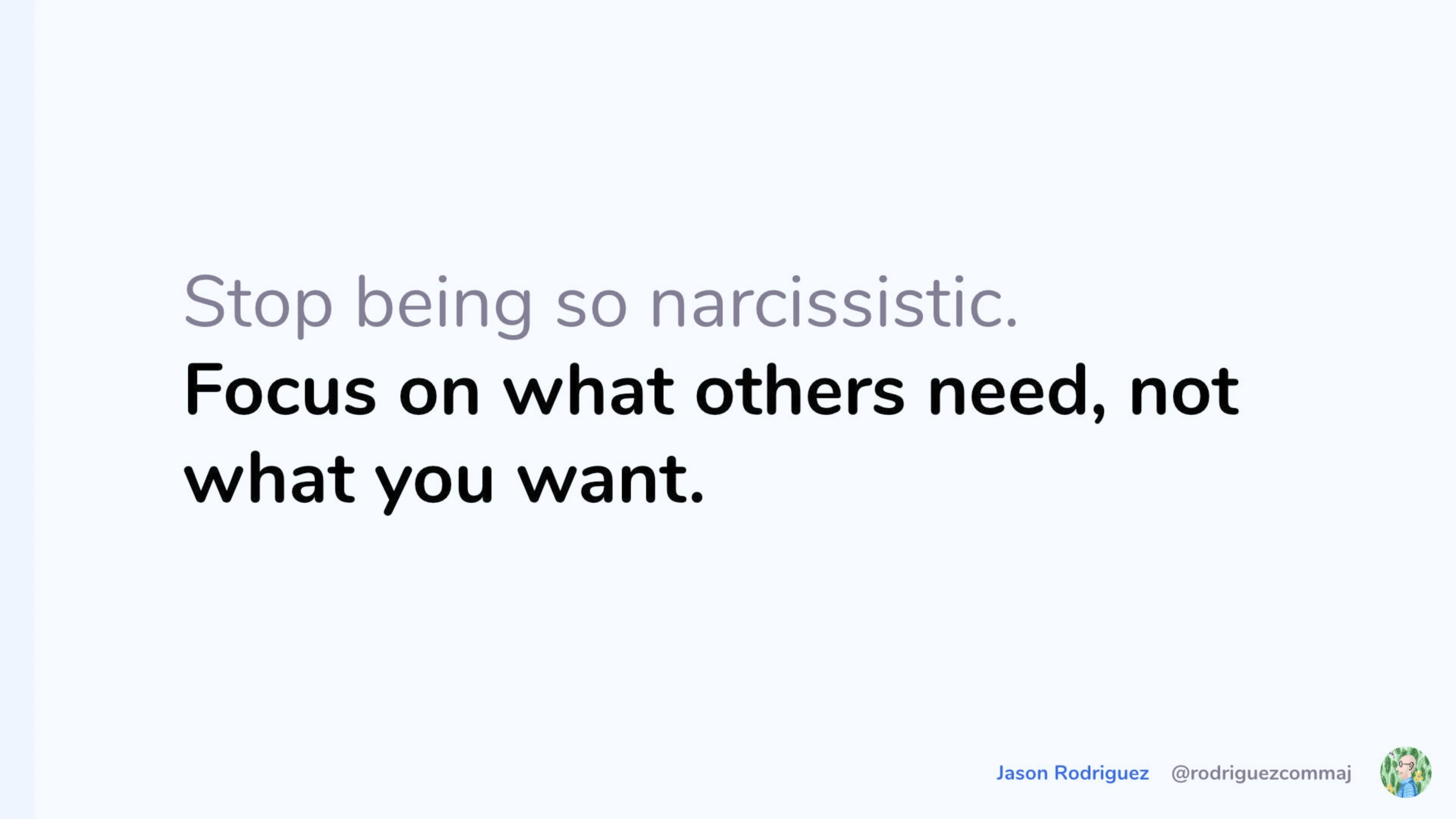
When we're talking about this conference specifically, that idea was brought up that emails are far too often narcissistic. We have goals as email marketers. We have goals as businesses. Far too often, we're focused solely on those goals as opposed to what our subscribers need out of us. I think that's the goal here is to focus on what your subscribers need throughout that lifecycle. Whether you're just acquiring them. Whether they've been around for a long time, you're still trying to engage with them.
Even through to the unsubscribe process. Take all of these values along with you throughout that process and figure out what they need. If they need it quick unsubscribe, give it to them. Don't make them jump through all these hoops and respect them as individuals. So really when it comes down to it, stop being so narcissistic and focus on what others need and not what you want.
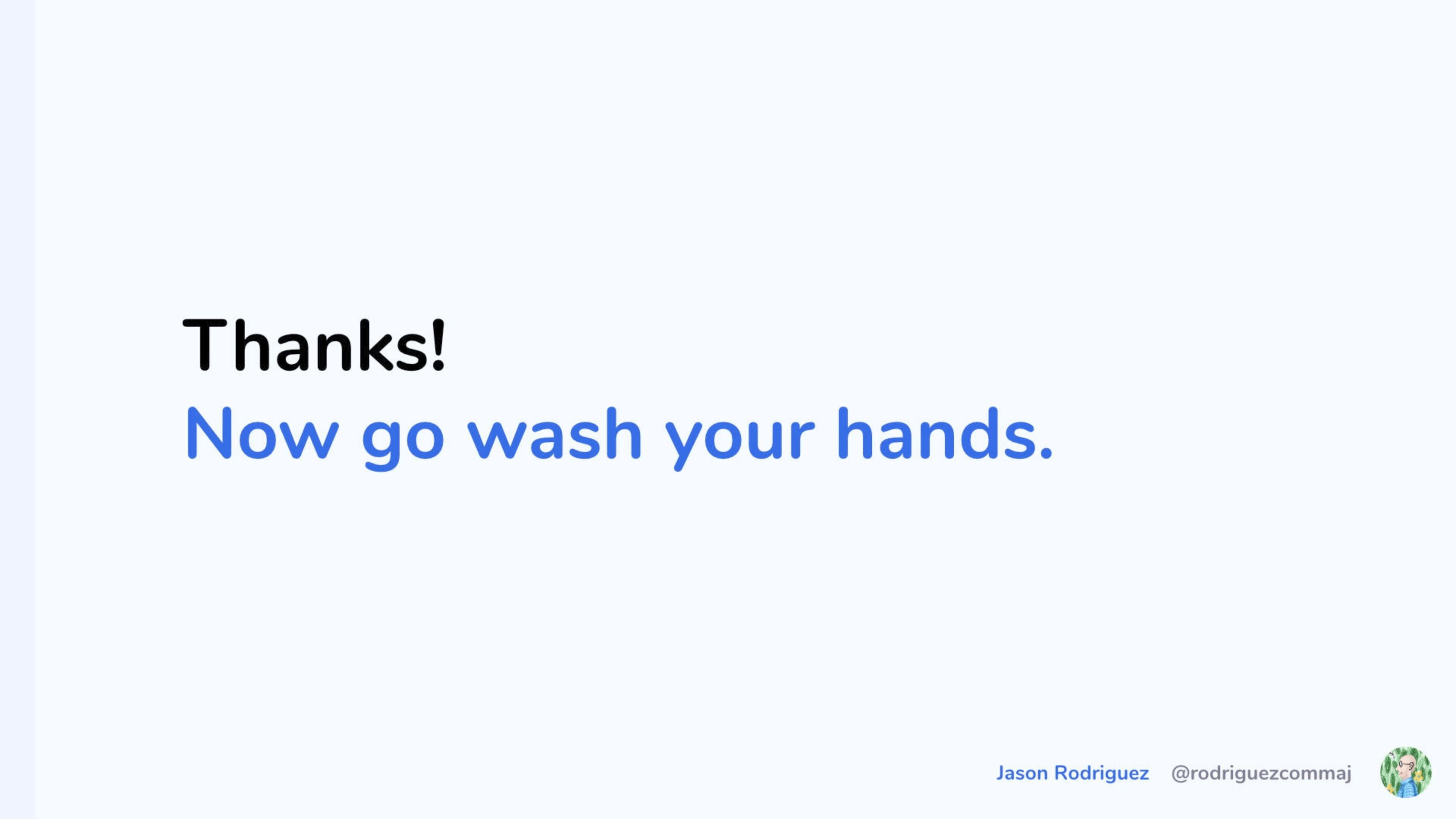
Thanks. Go wash your hands.
